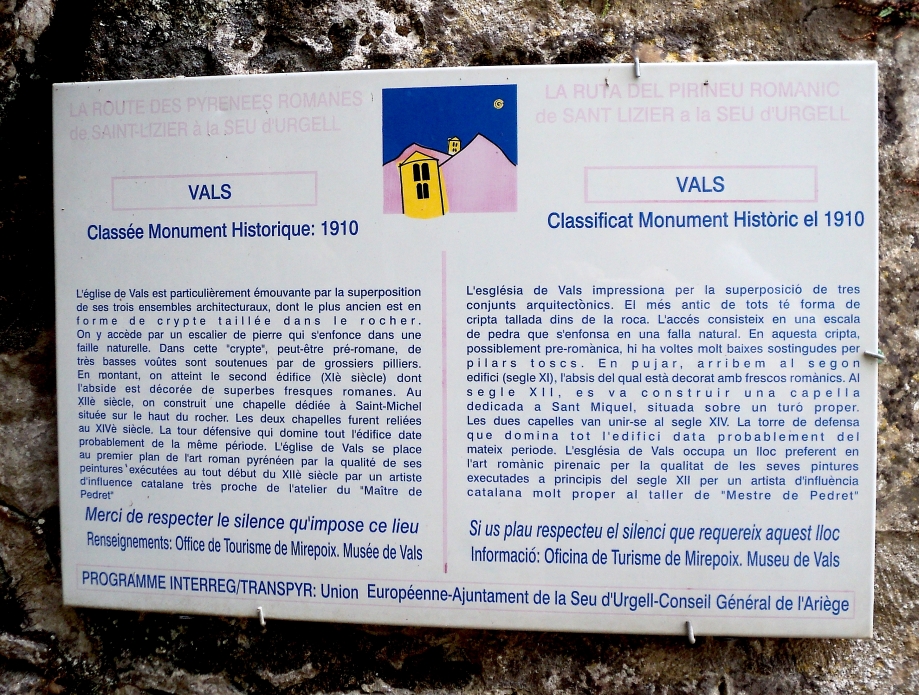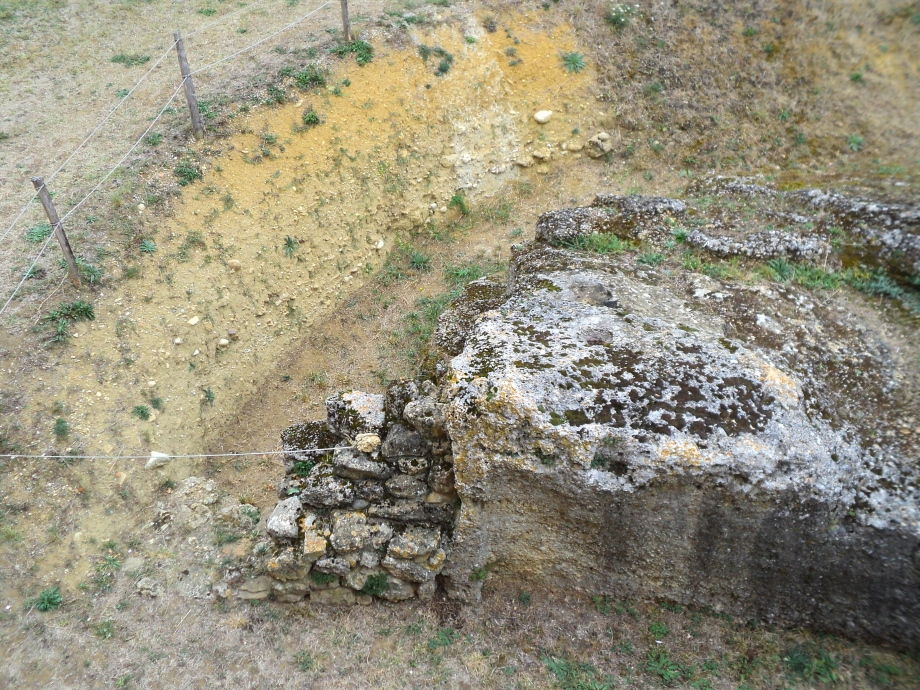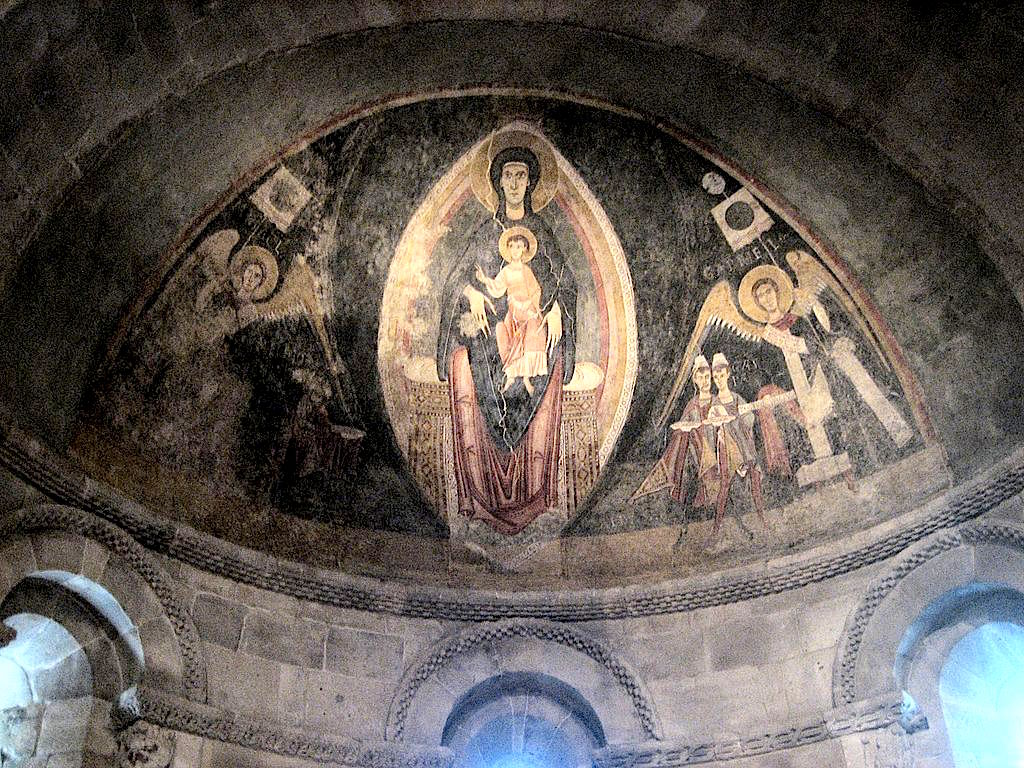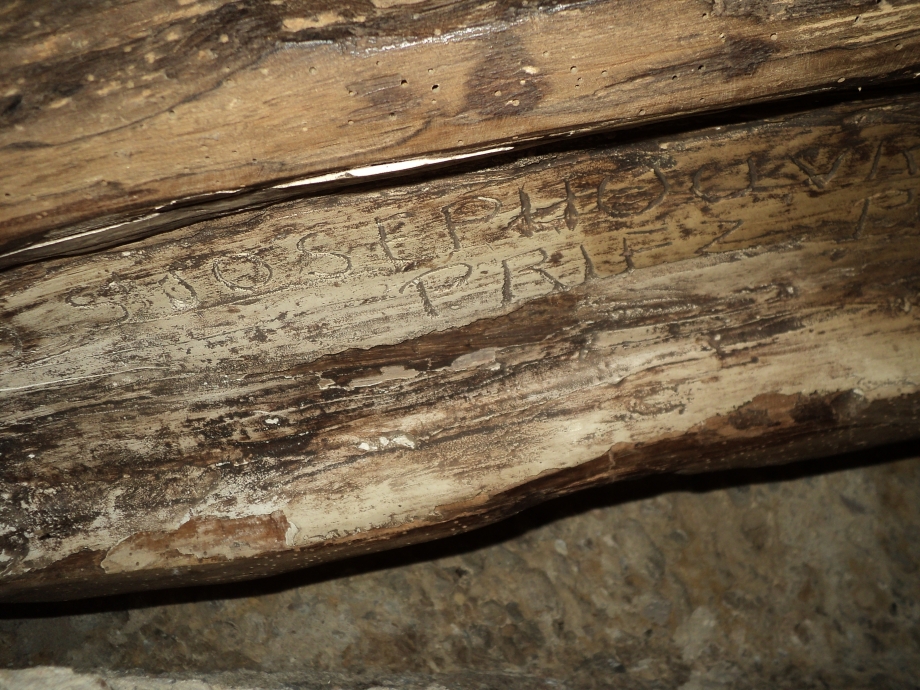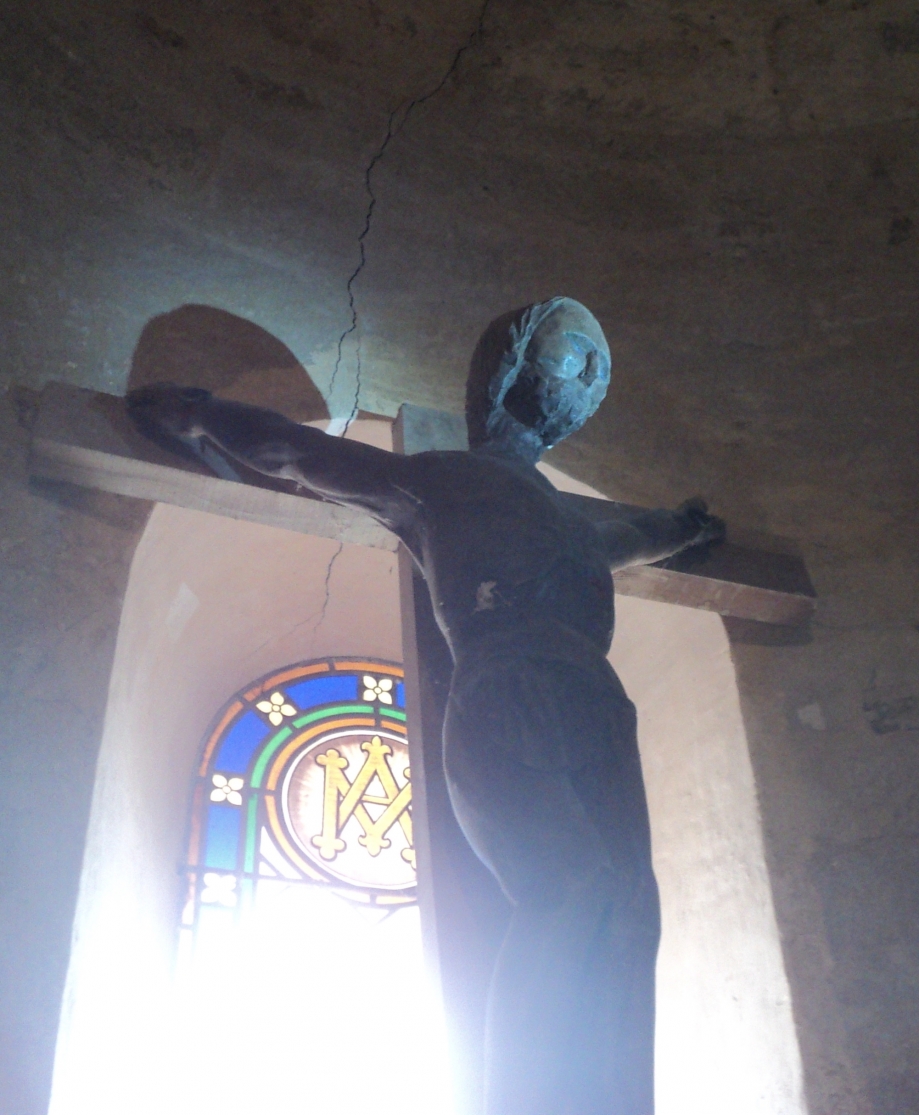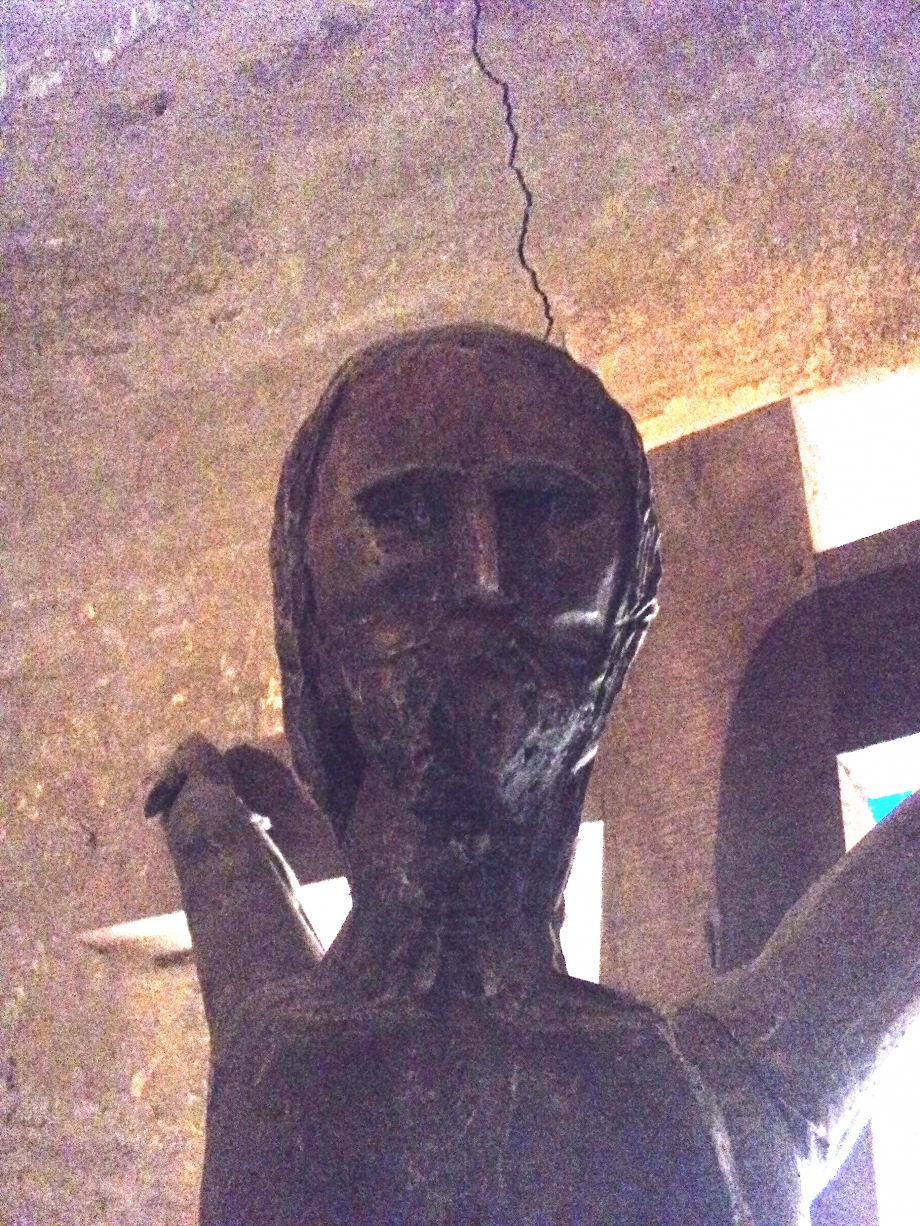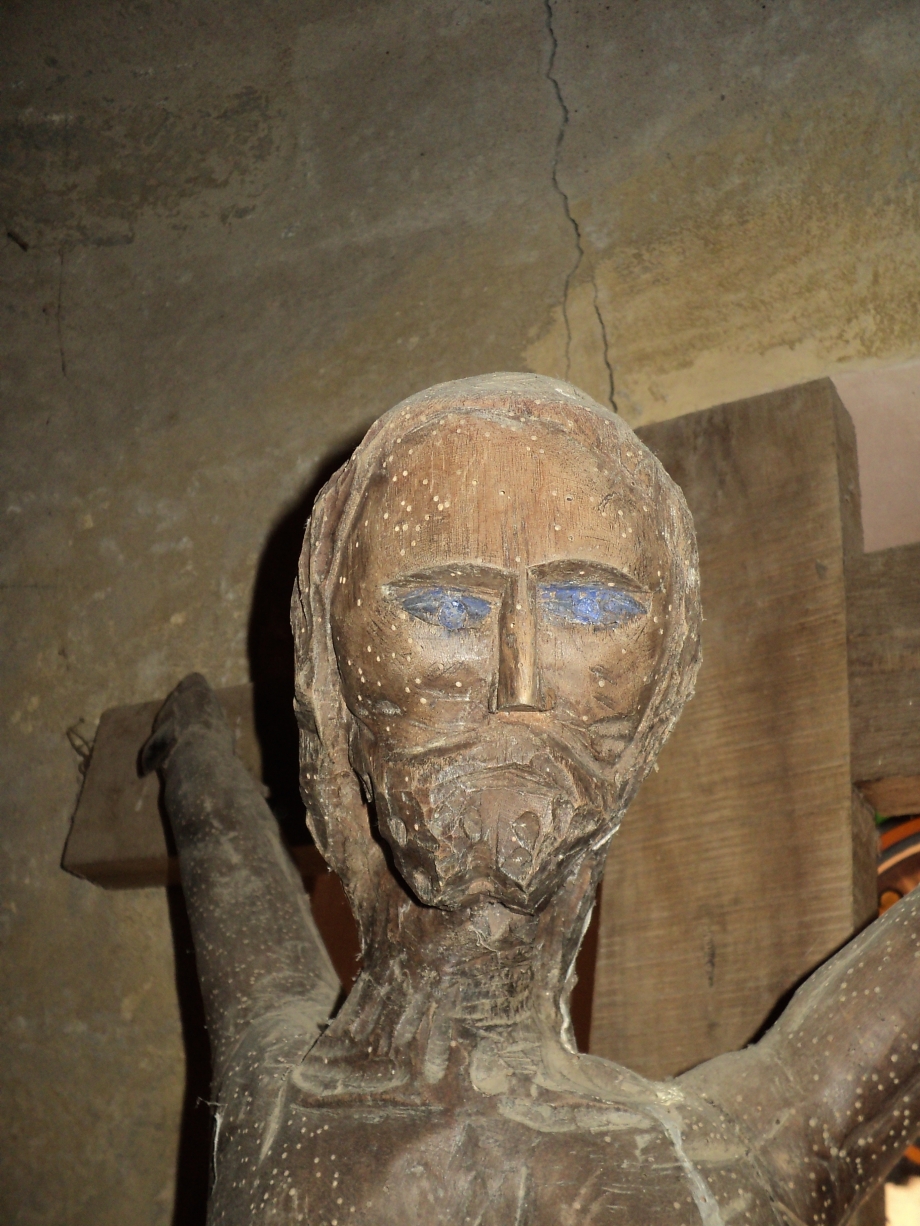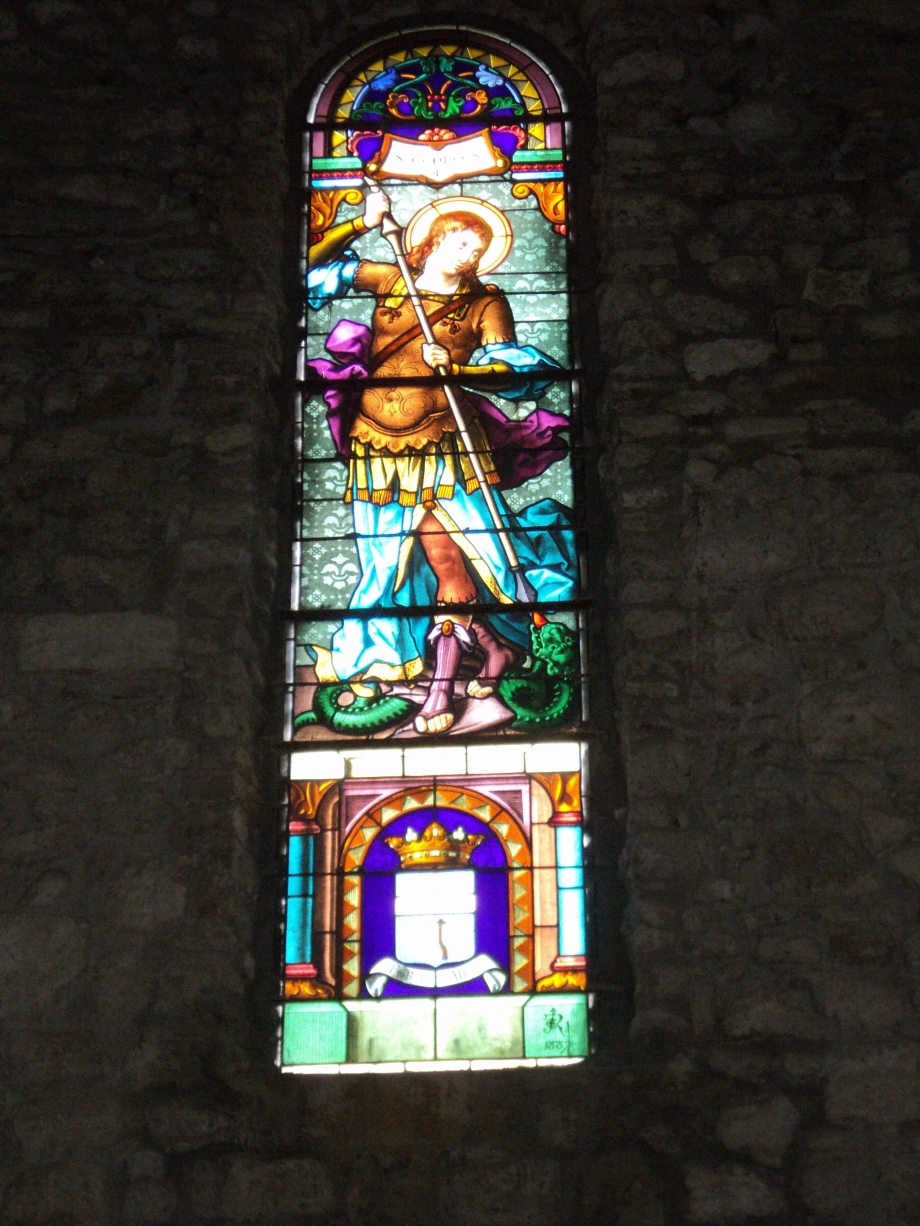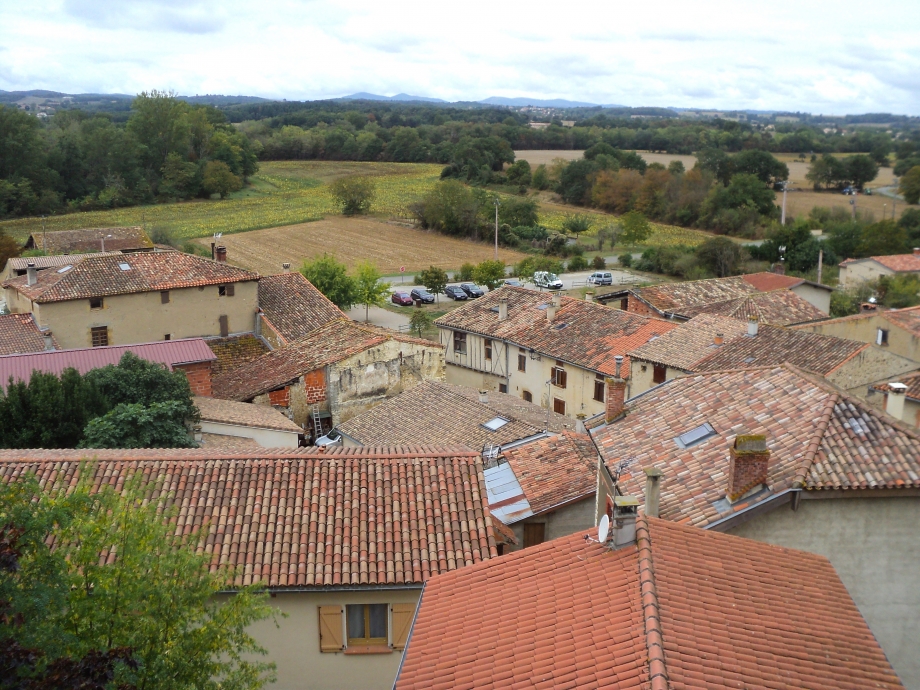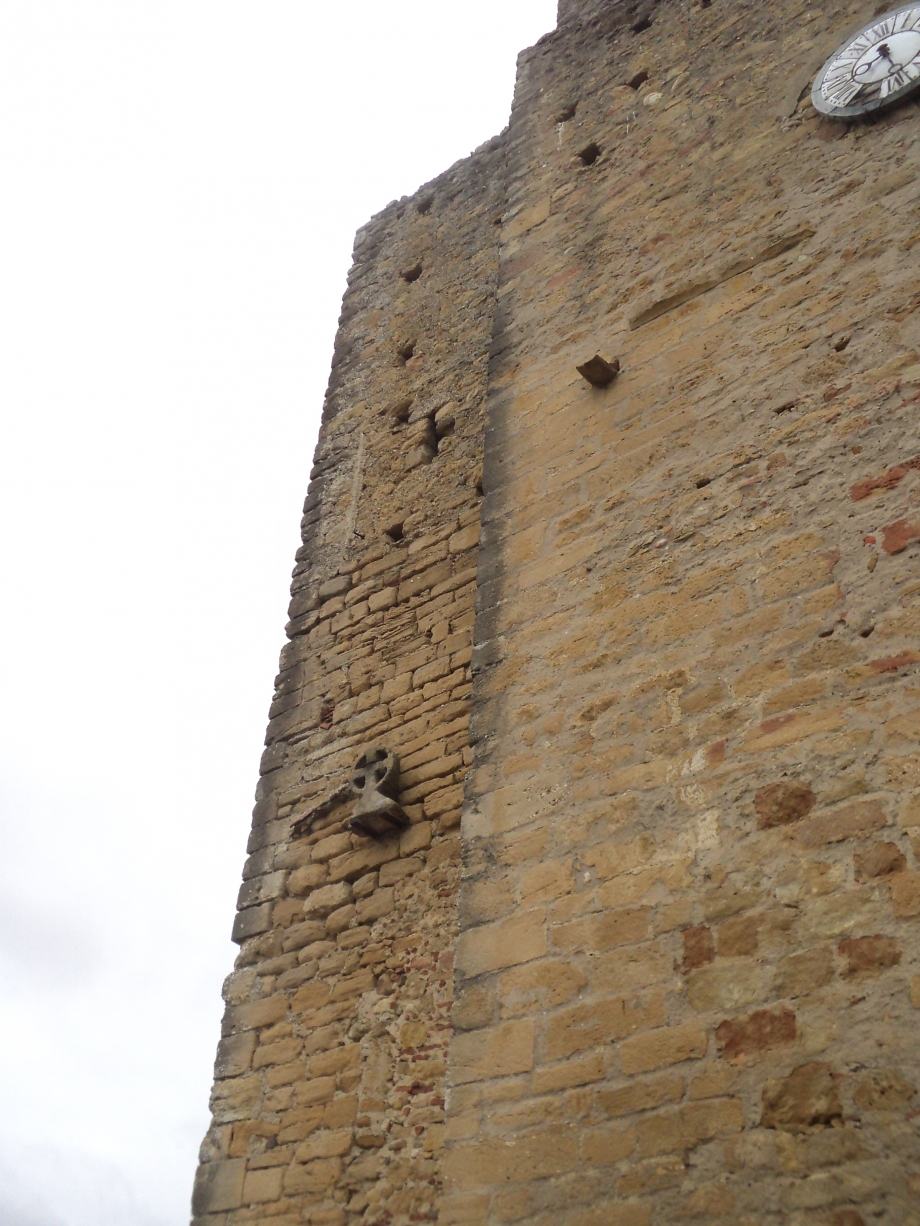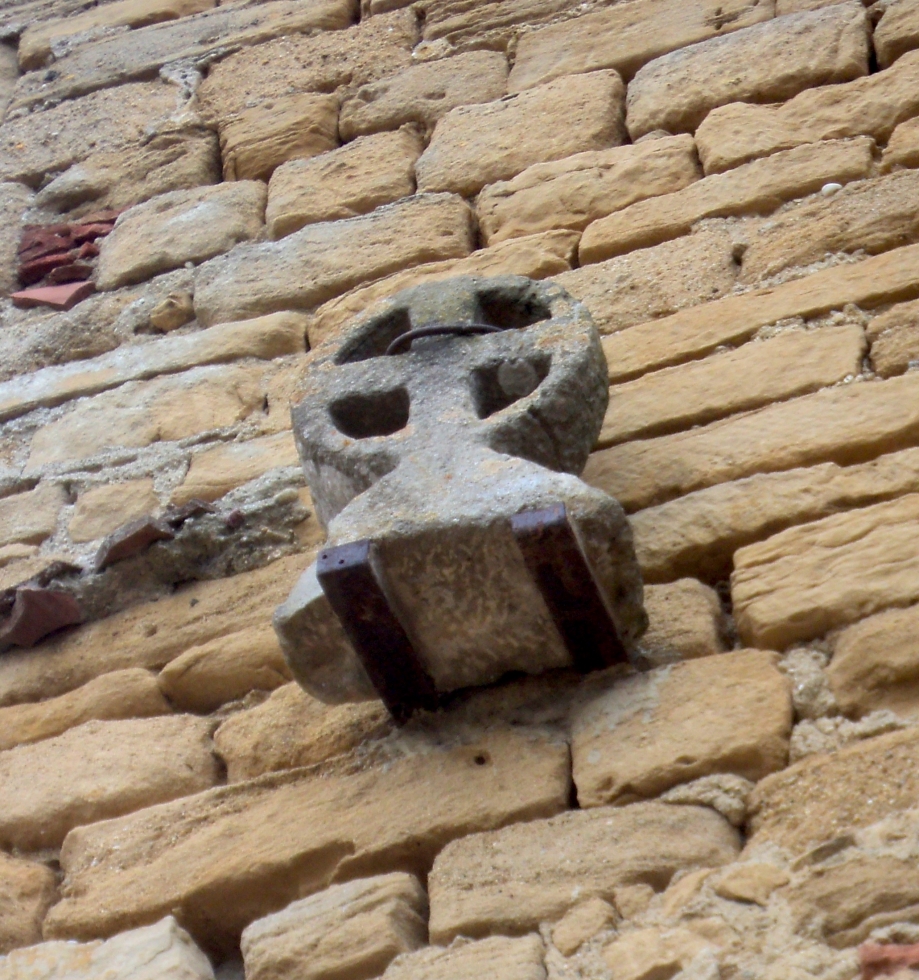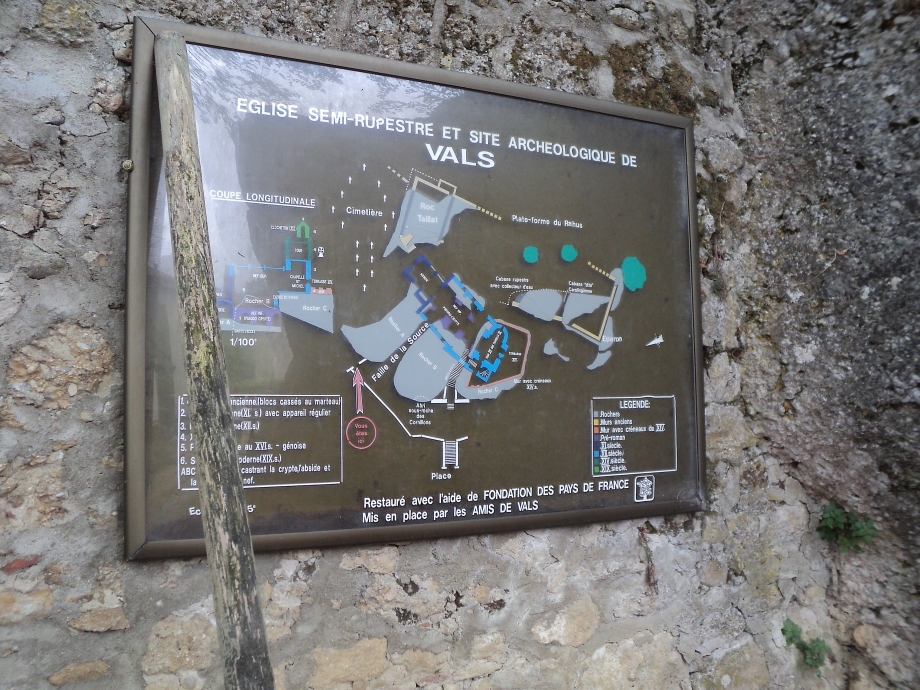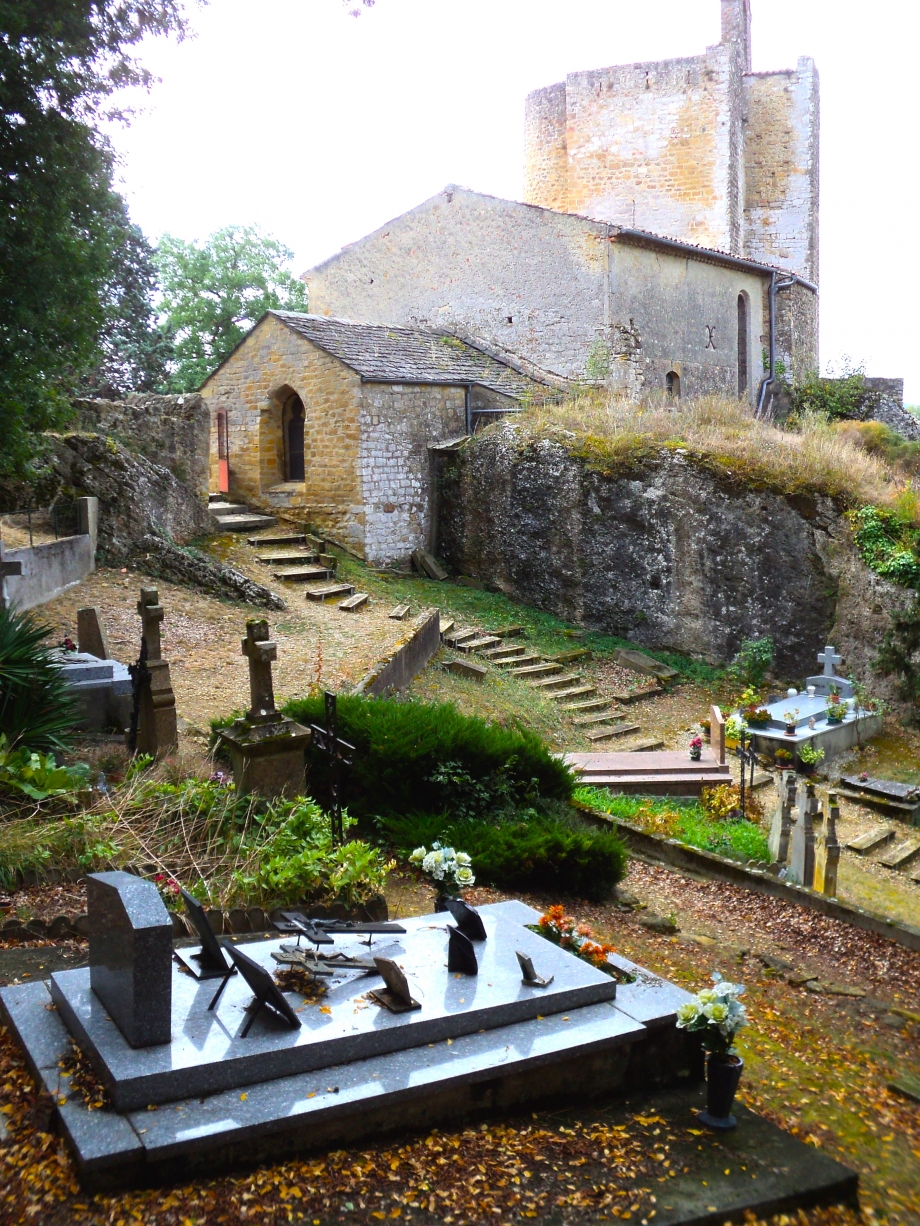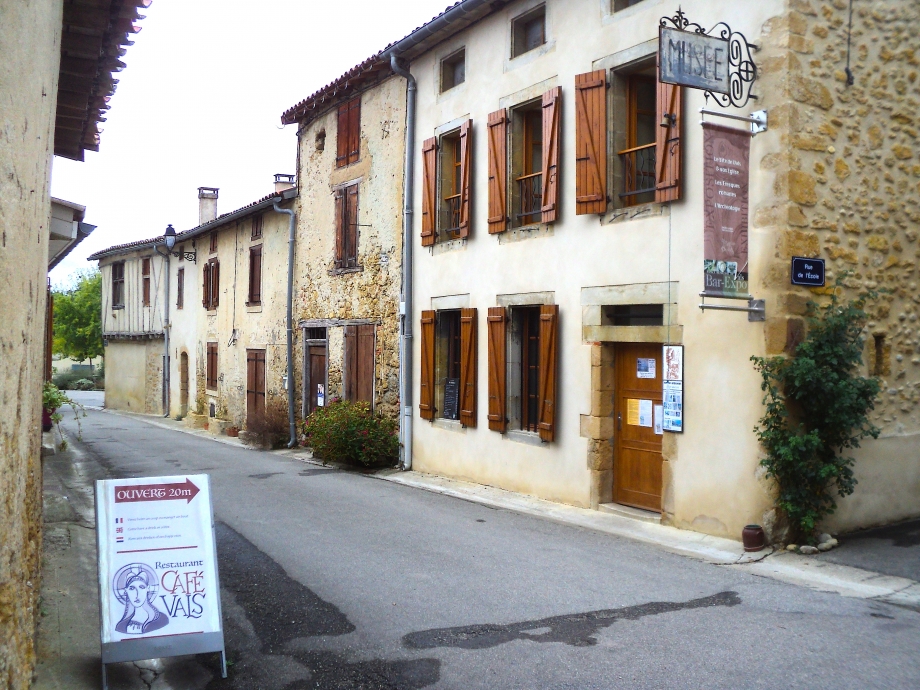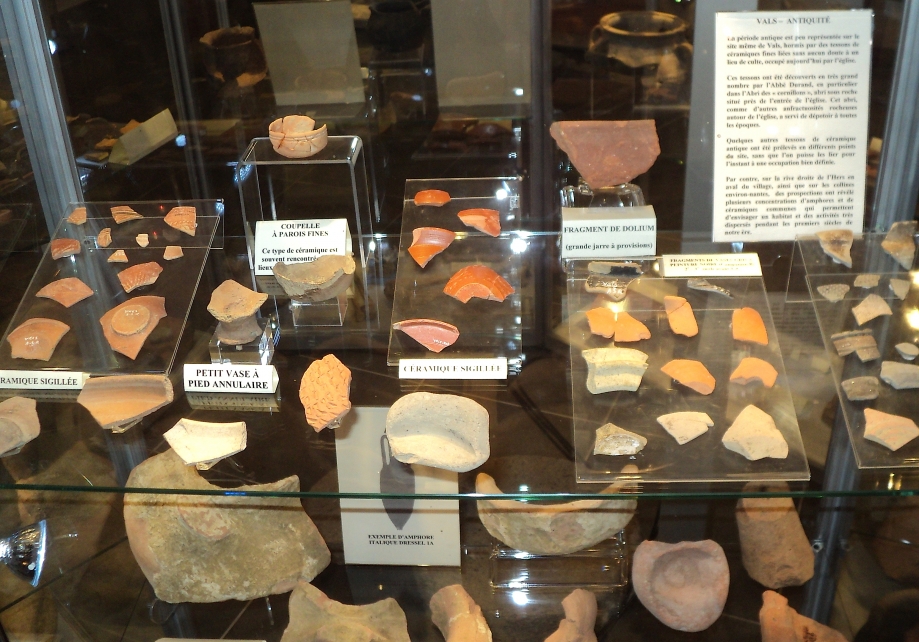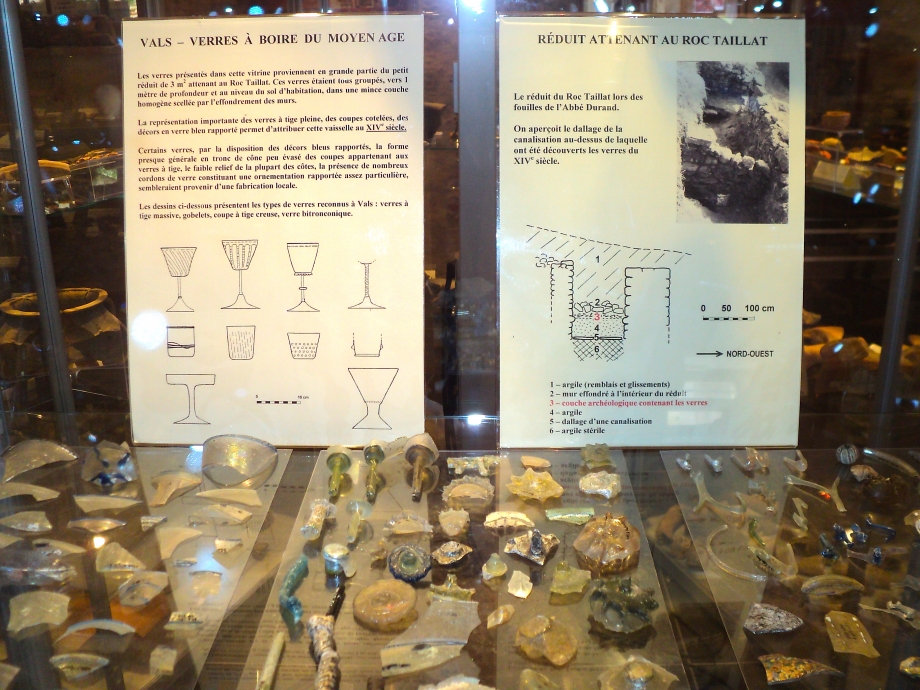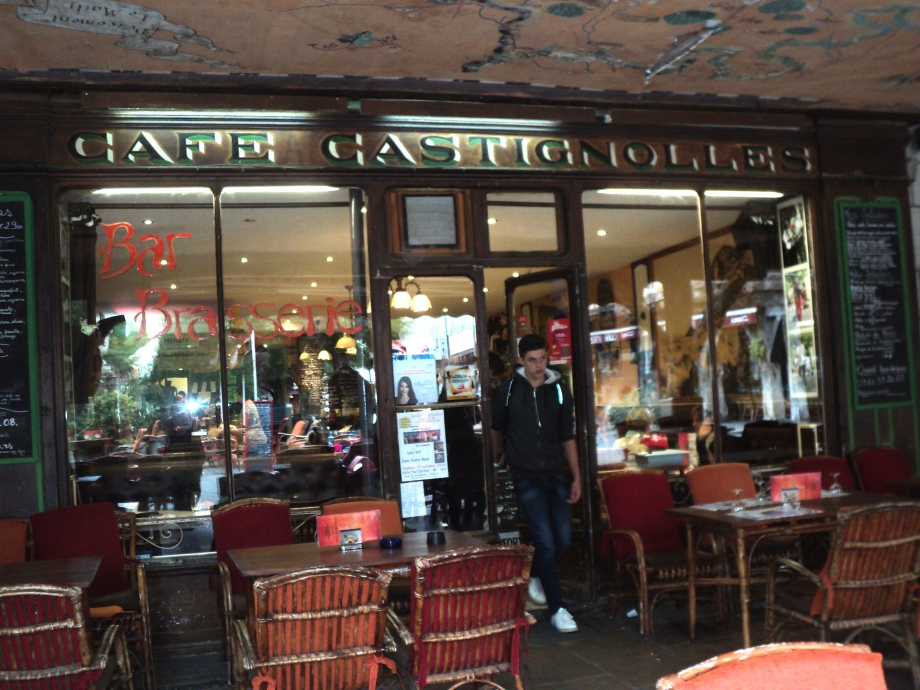ADVENTURES - Vals near Mirepoix
I have been wanting to visit the village of Vals ever since I found out about Guillaume Azéma who was a crossbow archer at Montségur, one of the two sergeants leading this skilled force.
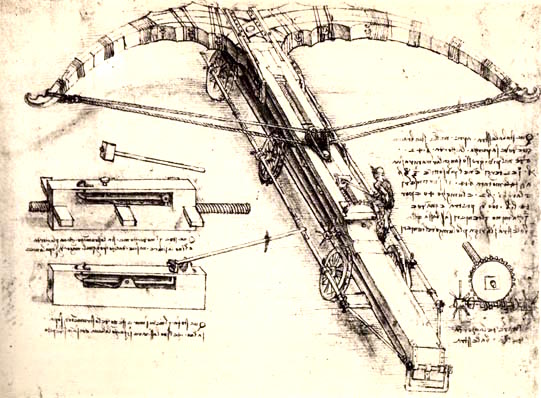
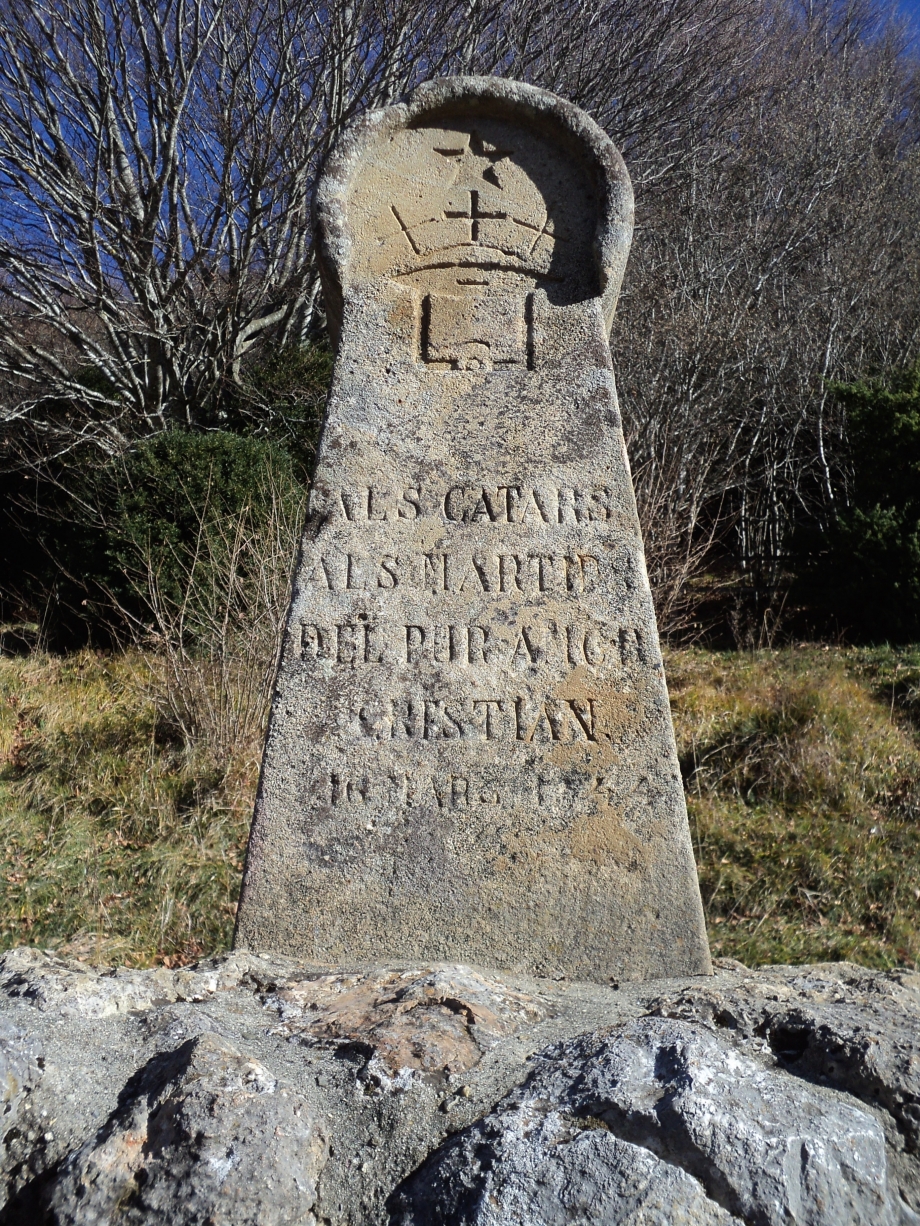
A crossbow as designed by Leonardo da Vinci c. 1500
I believe Guillaume was an ancestor of my previous life, Jules Azèma, who lived in the late 19th and early 20th centuries in the Narbonne region.
Guillaume was one of the Cathar aristocracy, a co-seigneur of Mirepoix since 1207, a personal friend of Pierre Roger de Mirepoix and Imbert de Salles, the two leaders of the raid against Avignonet in May 1242. The Inquisitors were staying there and an accomplice let the Cathars in. The raiding Cathars then threw the soldiers off the battlements and killed all the Inquisitors while they were eating. The next day Pierre Roger asked for the head of the inquisitorial monk called Guillaume Arnaud as a souvenir and said to Guillaume Azéma, "Traitor, why have you not brought to me the cup of the head of Brother Guillaume Arnaud?"
"Because the cup is broken!" replied Azéma.
They were referring to the old custom of the Visigoths, of preserving the heads of their enemies taken in battle. Sometimes the cranium was encircled with a band of gold and used as a drinking cup especially for wine. But this time the skull had been cracked wide apart, having been hit with an axe.
Pierre-Roger himself had not gone with the soldiers to ensure he could not later be accused of murder. He had been dispossessed of all his lands in 1229 to the profit of the Marshall Guy de Lévis who was given Mirepoix by Simon de Montfort. A knight without property, Pierre-Roger joined his cousin, Raymond de Péreille at Montségur in 1234 and married his cousin's daughter, Philippa, a year later.
This raid at Avignonet was well documented by the Inquisition, the records still exist. Guillaume Azéma is called throughout Guillaume Azéma de Vals. It was noted he had a particular hatred for the priests and monks of the Inquisition, but we don't know why.
Both before and after the raid, Pierre Roger and his troop of soldiers were cheered by local people when they later made their way home, and were wined and dined at the homes of Cathar friends and villages as they boasted how they had killed the Inquisitors. Their actions were very popular, ever since help for a more serious campaign had been refused by high-ups in Toulouse.
Guillaume Azéma returned to his home at Vals before continuing to resume his duties at Montségur. He served at Montségur from 1240 until the end. He was wounded during the Christmas 1243 attack by Gascon mercenaries and it is known that he recovered, it's thought he was healed by the Cathars. Guillaume was not officially a Cathar; before the Cathars were burnt alive in March 1244 they distributed their goods to the people who had guarded them, and Guillaume received a sack of wheat from the lady Raymonde de Cuq. When the siege ended he was allowed to return home to Vals. And there the trail ended. I can find no further record of him although it's unlikely the Inquisition, who called in everyone who was at Avignonet in 1242, never interviewed him.
He was probably the eldest son for he was named after his father, Guillaume Azéma. From 1209 until father Azéma's death in 1227 Vals was known as a safe house or sanctuary for Cathars travelling to and from Spain and passing Montségur, some 15kms south of Vals. Guillaume senior was a knight who "assisted the Cathar preachers at Mirepoix."
If we assume Guillaume Junior was aged around 27 when he became a co-signeur of Mirepoix in 1207 - 2 years before the crusade against the Cathars began - we can assume he was born around 1180 and his father around 1160.
You can read more about Guillaume by clicking here.
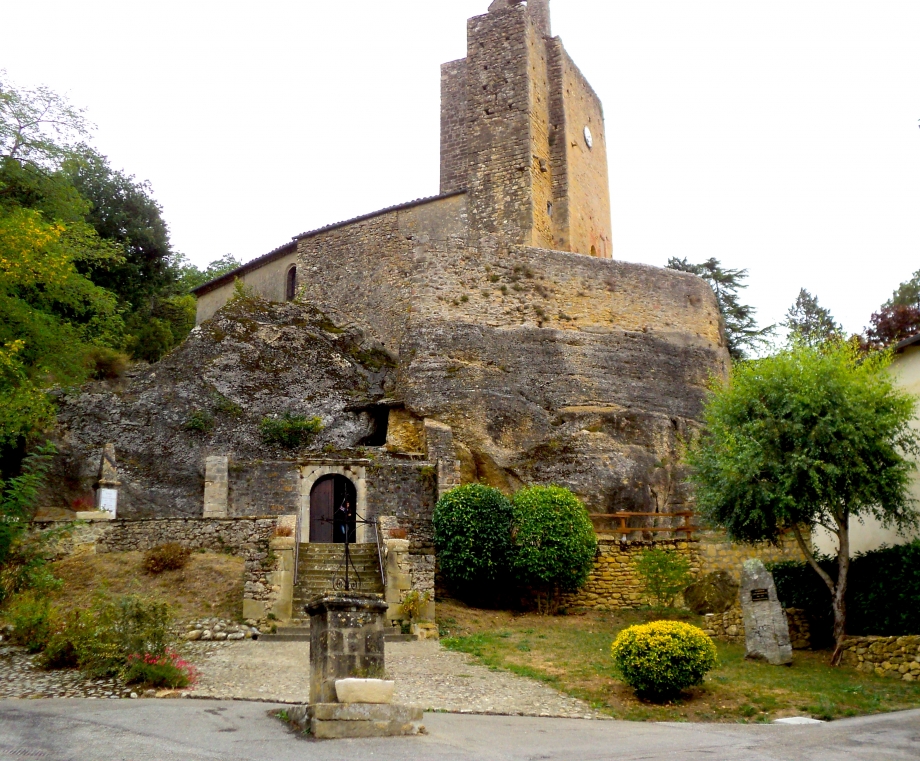
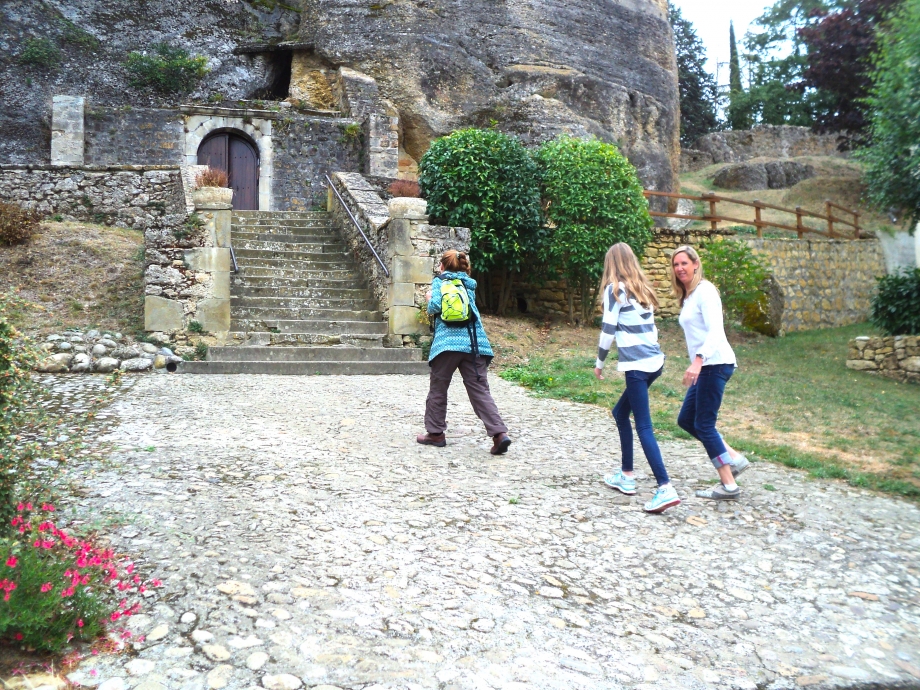
I had heard about the incredible "underground church" at Vals and because of Guillaume had wanted to visit for many years. A group of is went in October 2016, me, Tina, Lauren and Mary.
Before we entered we saw a plaque of information which I noticed was in French and Occitan, but not in English;
Here's the translation; the church is particularly known for its three types of architecture, one imposed upon the other, of which the most ancient is a crypt carved into the rock. One goes up through a natural fault in the rock. In this crypt, maybe pre-medieval, the low arches are supported by wide pillars. One climbs to the second building, 11th century, in which the abside (ceiling) is decorated by superb medieval frescoes. In the 12th century, above this, was a high chapel dedicated to Saint Michel. The two chapels were linked in the 14th century. The defensive tower probably dates from the same period. Vals is famous - in the first rank - for its Pyrenean medieval art, with the paintings executed in the 12th century by an artist under the Catalan influence of the "Maître de Pedret." I noticed that there was no mention of a Cathar past.
Then we went through that church door and were - what - hooked? Forever!
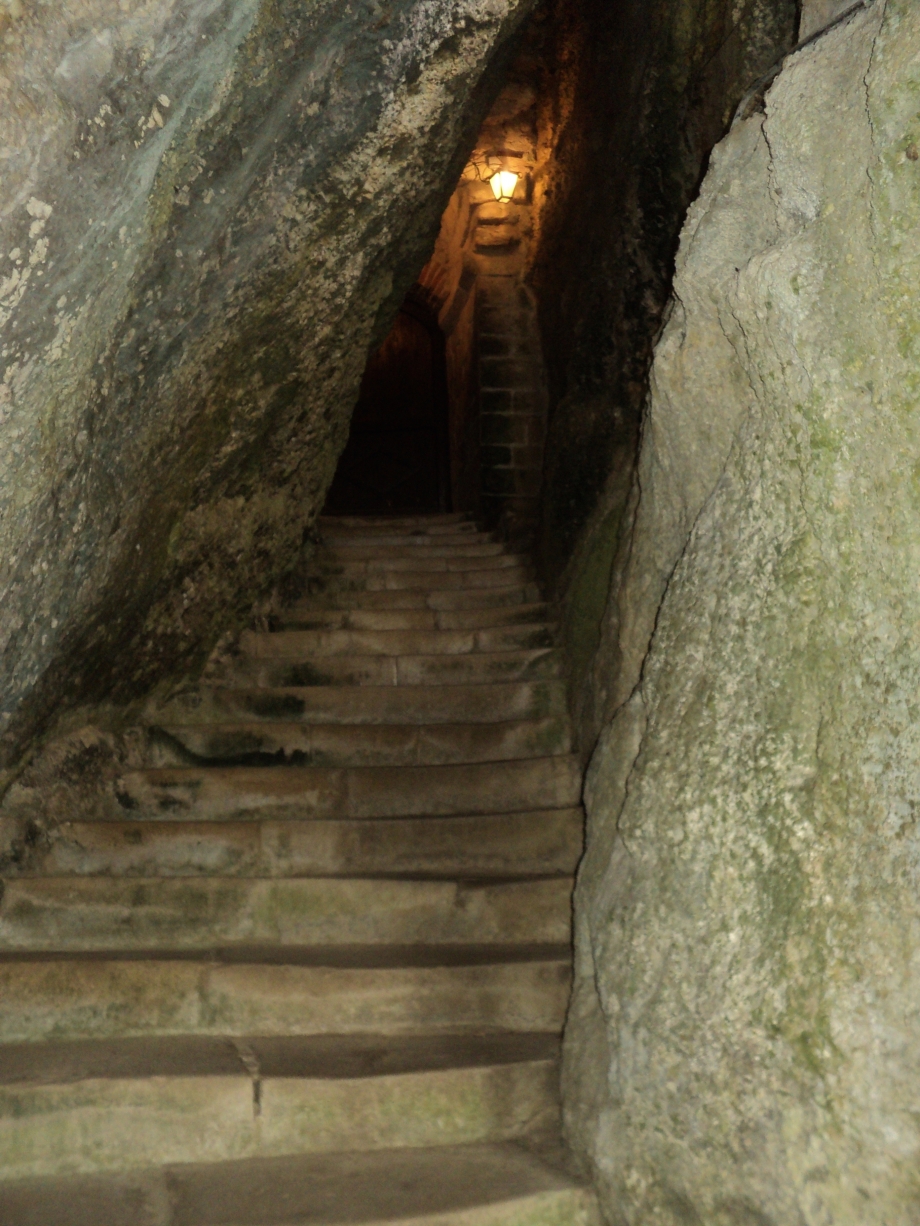
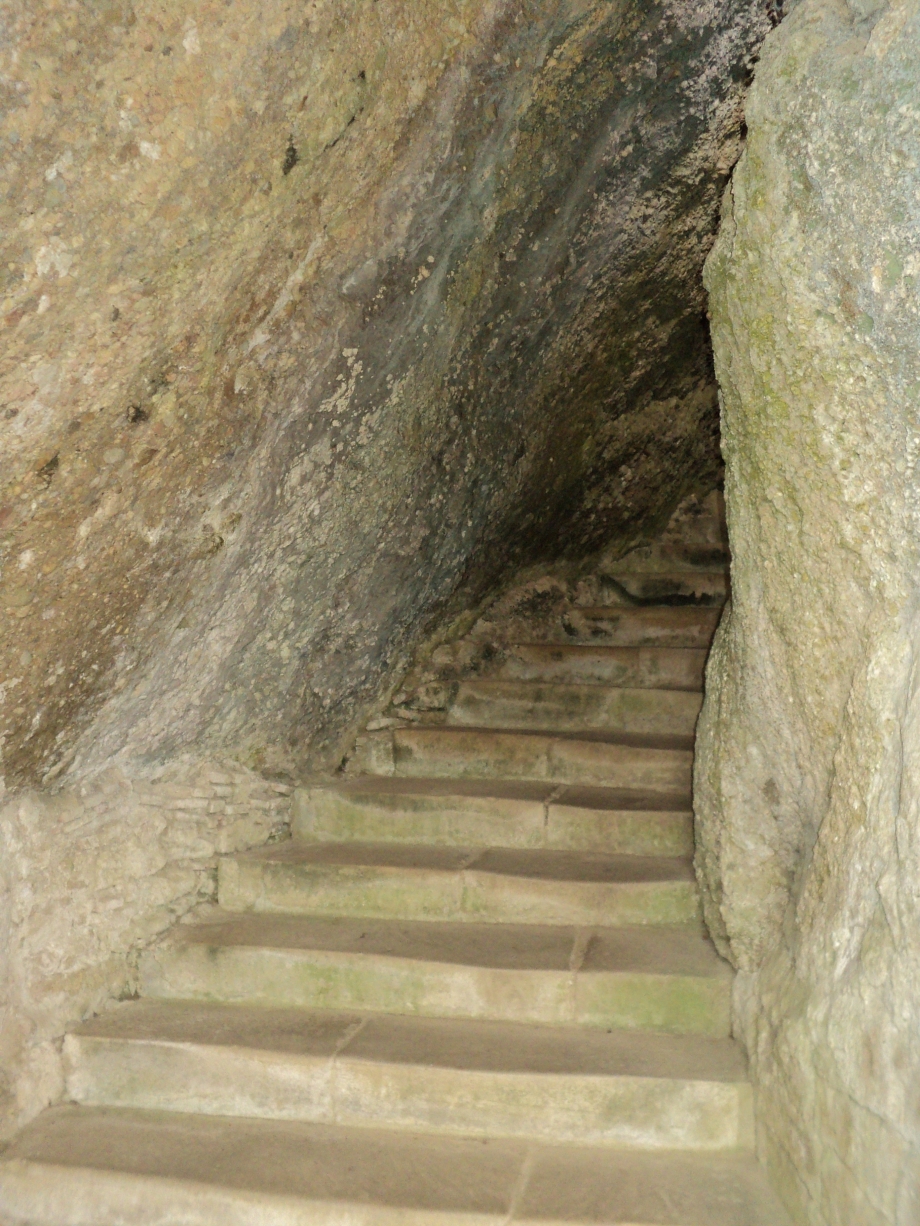
Not to put too fine a point on it, entering that door and climbing the steps was exactly like entering a woman's body. We were going deep into the earth. The French speak more frankly about the things, and talk about "le ventre" - the womb of the earth. ( Click here for a film in French.) The church is very popular with "sacred feminine" pilgrims who enjoy the journey from the secret entrance - material - to the near-heaven chapel above, with its angel - spiritual.
This site is very old. It was originally built on the Oppidum of Rahus, now to the right of the church. The whole area has been excavated and they found evidence of Bronze age occupation. Bronze age was between 1000BC and 500BC, then mankind moved into the Iron age from 500BC. Bones, ceramics, broken glass found on the site can be seen in the little museum of the village. One thinks there was a cult related to the intermittent source which took birth in the little rocky gorge below the church. And maybe a Celtic temple existed there. There's also a mention of a settlement dated 2000BC, probably living in the caves.
It's possible the first inhabitants lived among these rocks, on the land beside the church called Talus, 4000 years ago.
The foundations of today's church were laid by the Benedictines in the 10th century (some sources say 8th) and are called "Carolingian." (Later, the Benedictines, especially at Limoux, refused to persecute Cathars.) The village of Vals was called Valle Peditario in 943 and was under the aegis of the abbey of Lagrasse, and then the abbey of Camon. The church first appeared in texts in 1104 when the rector of Vals, Annibal Grasieres, became one of the canons in the church of St Volusian in Foix, and so Vals was enlarged and became a priory. In 1224, Pope Honorius confirmed that the abbey of Foix had all rights over St Marie de Vals.
We continued our exploration, passing a tiny old font - original 10th century? - on the left and a bigger one on the right in the room known as the "baptistry." The low rounded arches are typical of 10th century architecture.
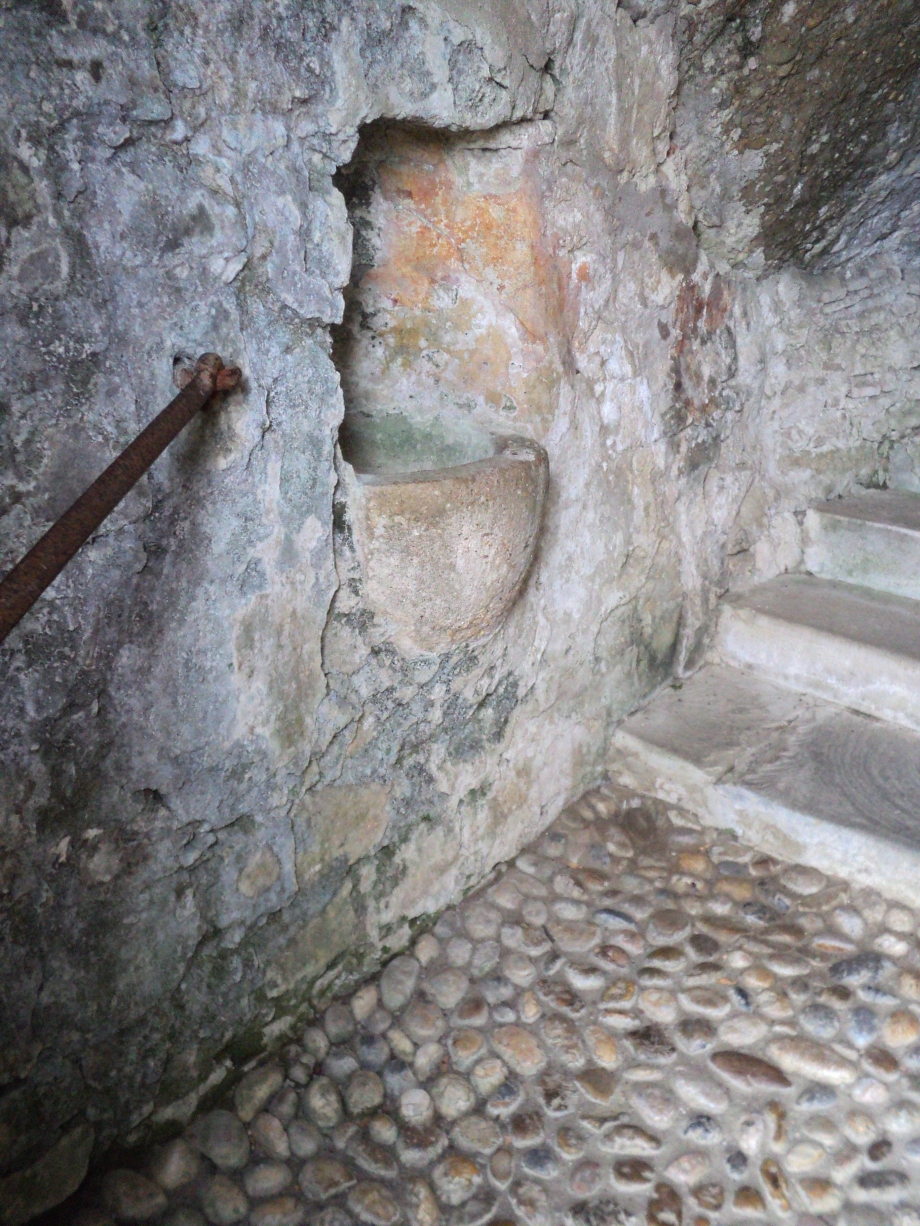
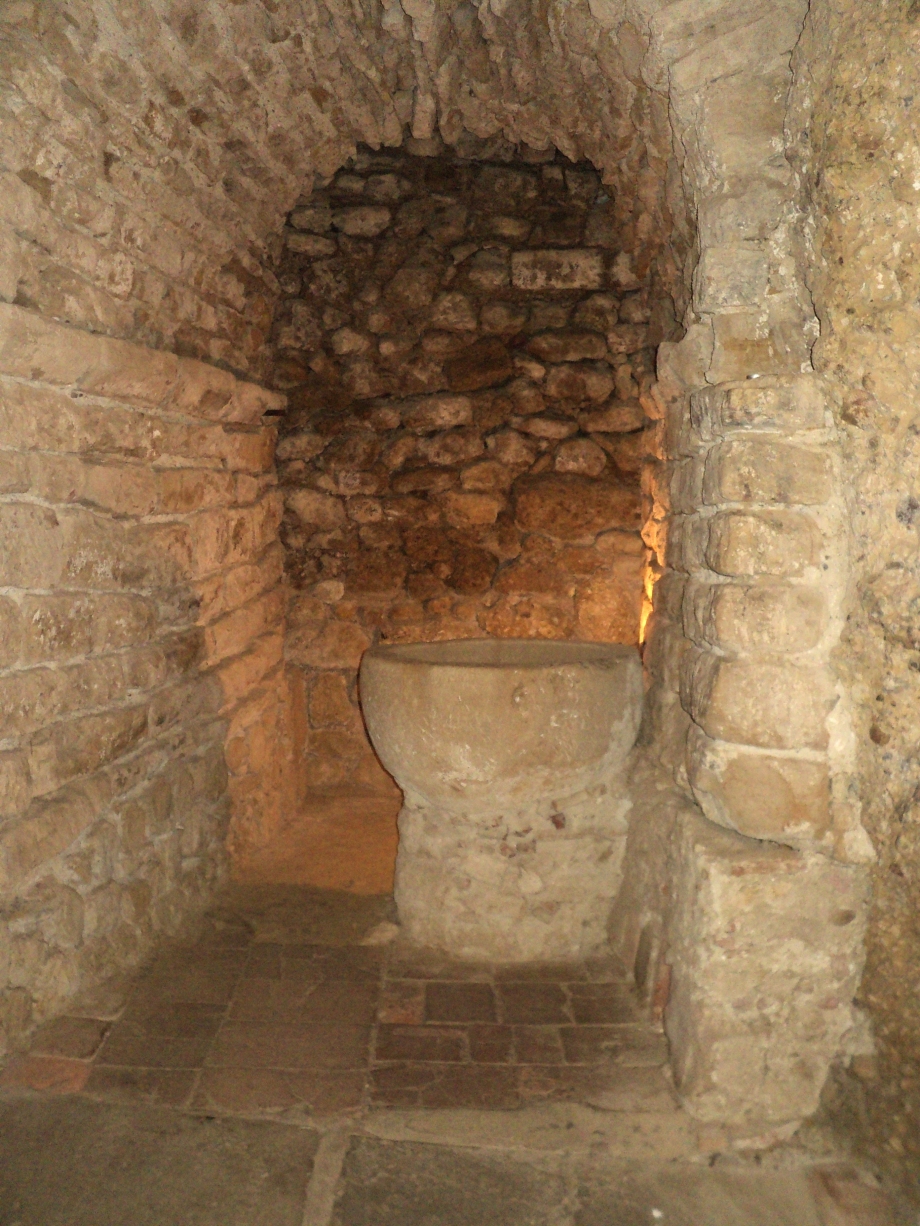
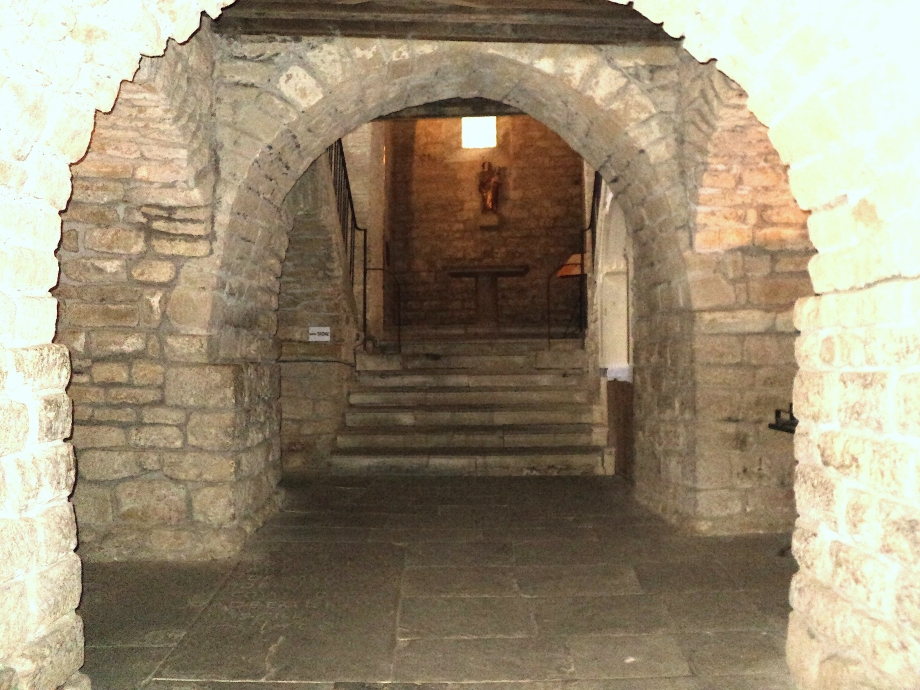
At the top of the steps we saw an Our Lady statue ahead of us. This was always a Virgin Mary/Mother Mary church. Its construction was finished "by the end of the 12th century" that is, 1199, during the time of both father and son Guillaume Azéma of Vals.
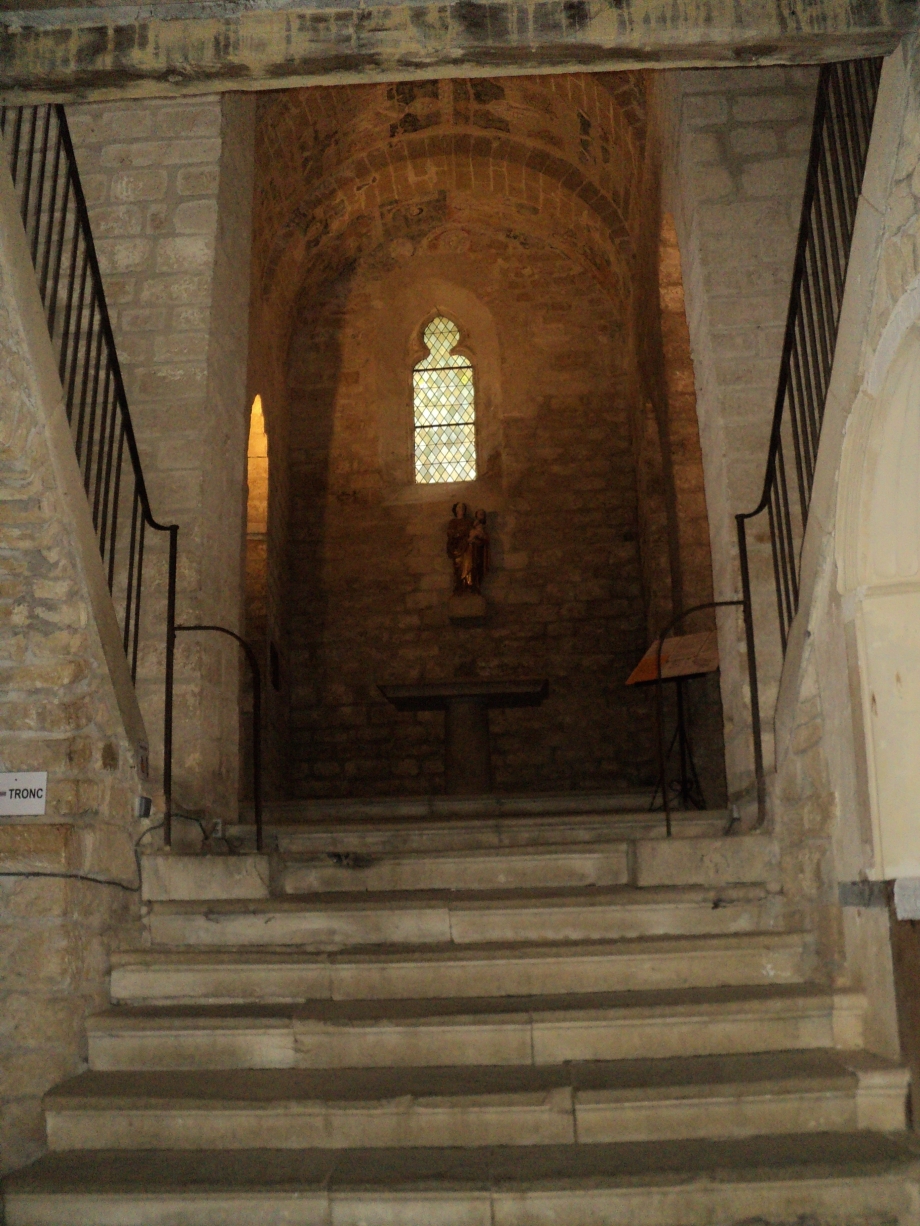
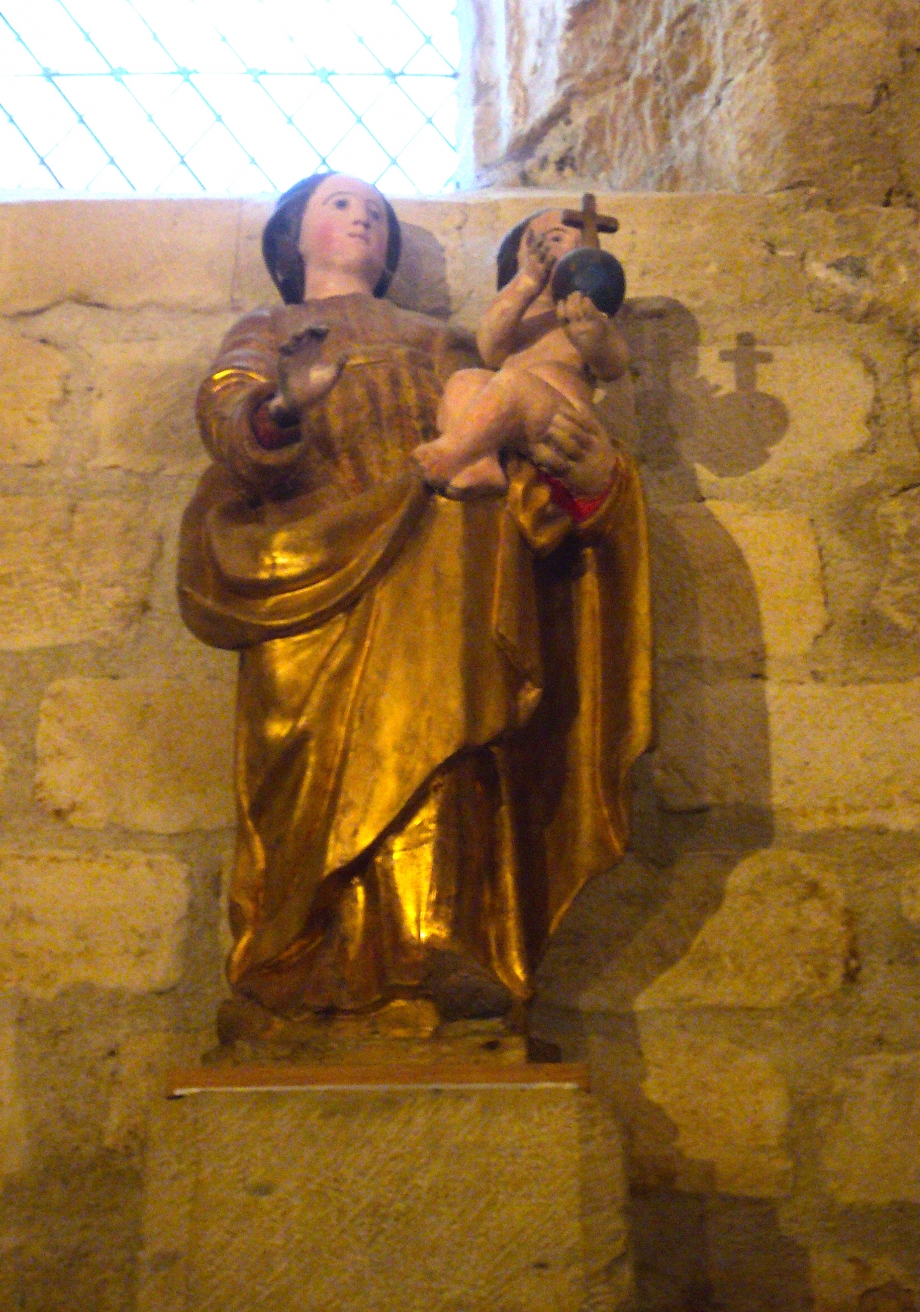
In front of the Virgin was an altar, just a marble slab on top of a concrete pillar. Many of us don't know that, way back in the early days of Christianity, the altar was just that - a slab, or a flat surface, where could rest the sacred objects of the cult.
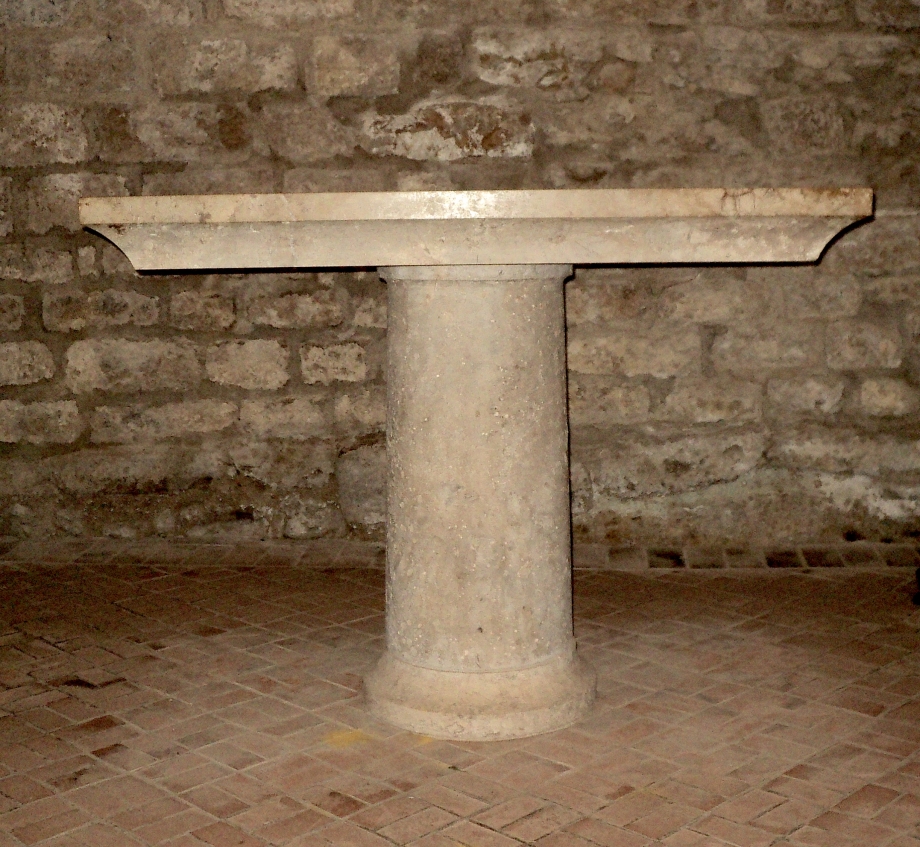
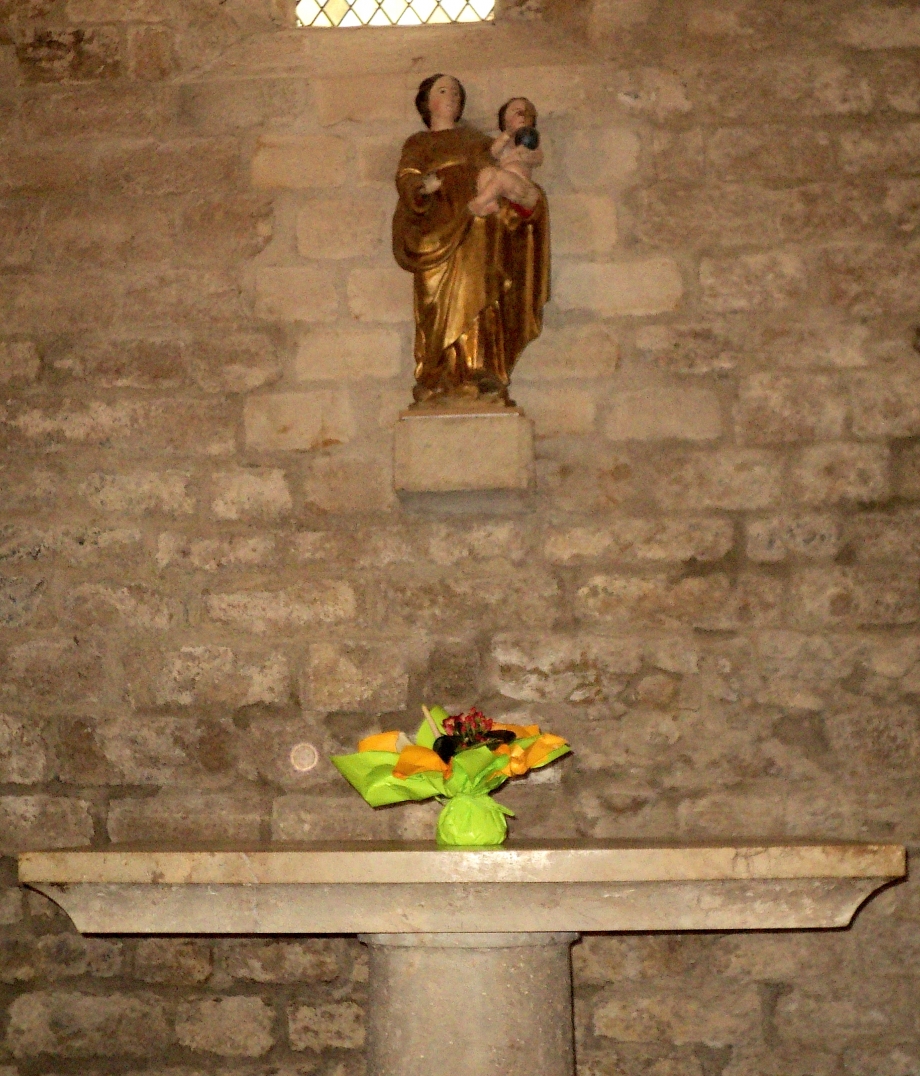
On a second visit, there had been a wedding in the church, and someone had left some flowers for Mary - and an Orb.
But what was staggering about this part of the church was the beautiful frescoes on the arched roof above the Madonna and her child. There are breathtaking. My friend Mary, who has studied history all her life, was ecstatic. "I have never seen this before," she said, She recognised instantly the four evangelists/advocats, who intercede for you if you haven't confessed your sins properly. They are sometimes called "pantocrator." This is a concept popular at the time but rare now, and the images in Vals are the only ones known in France.
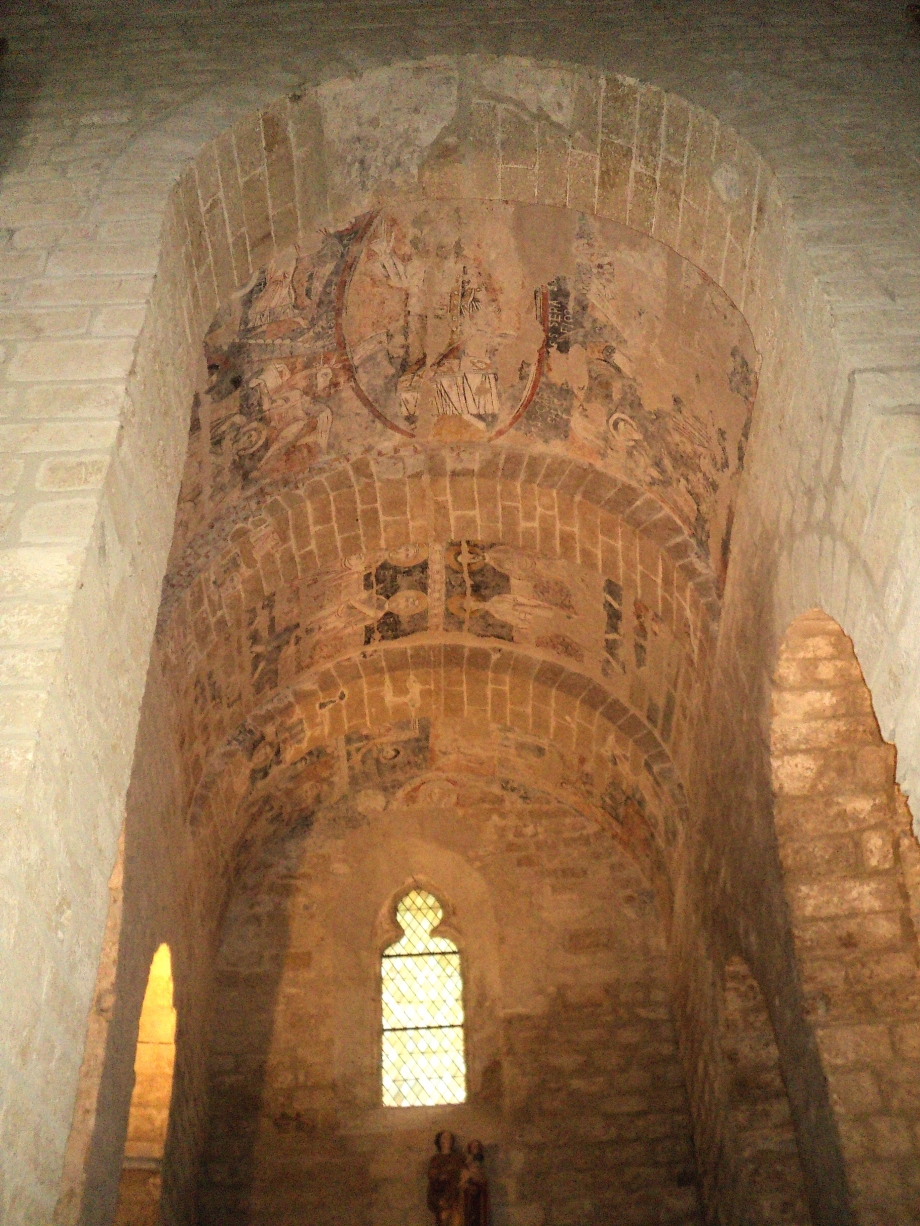
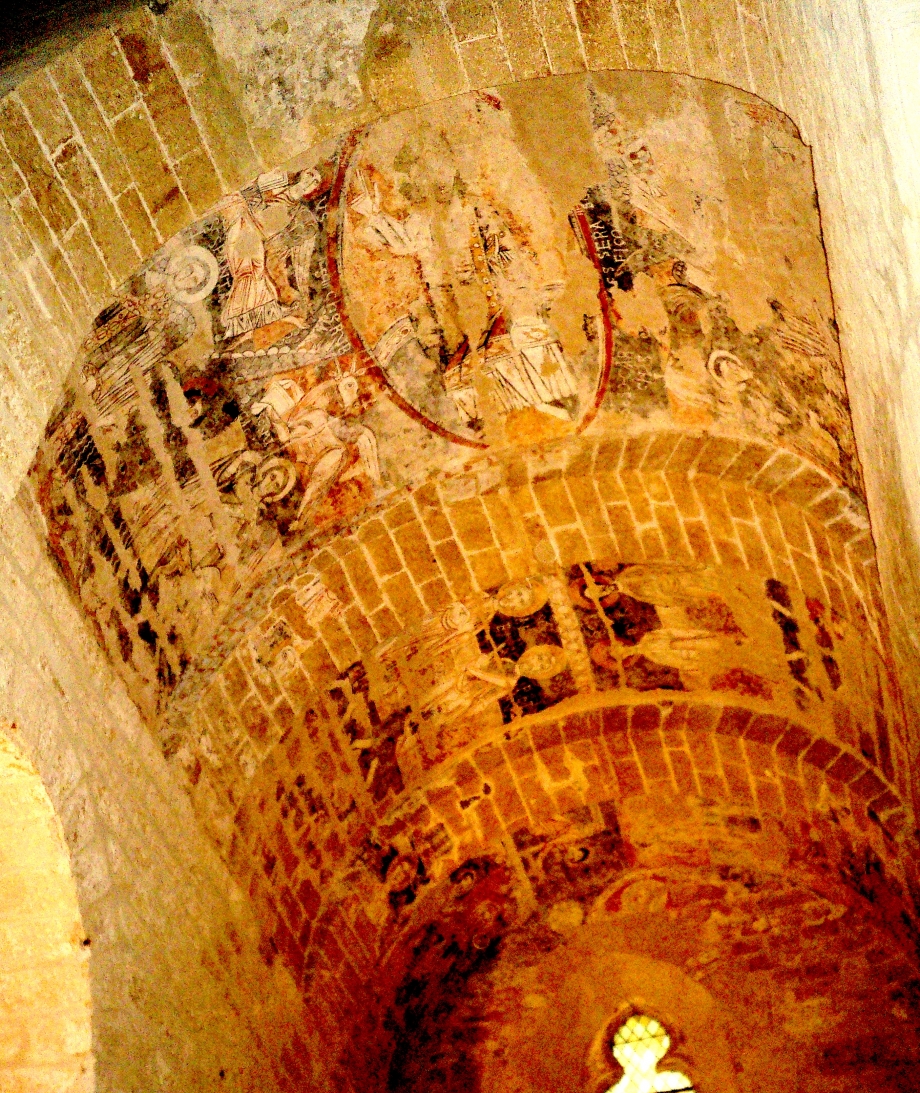
They are hard to photograph but I did my best!
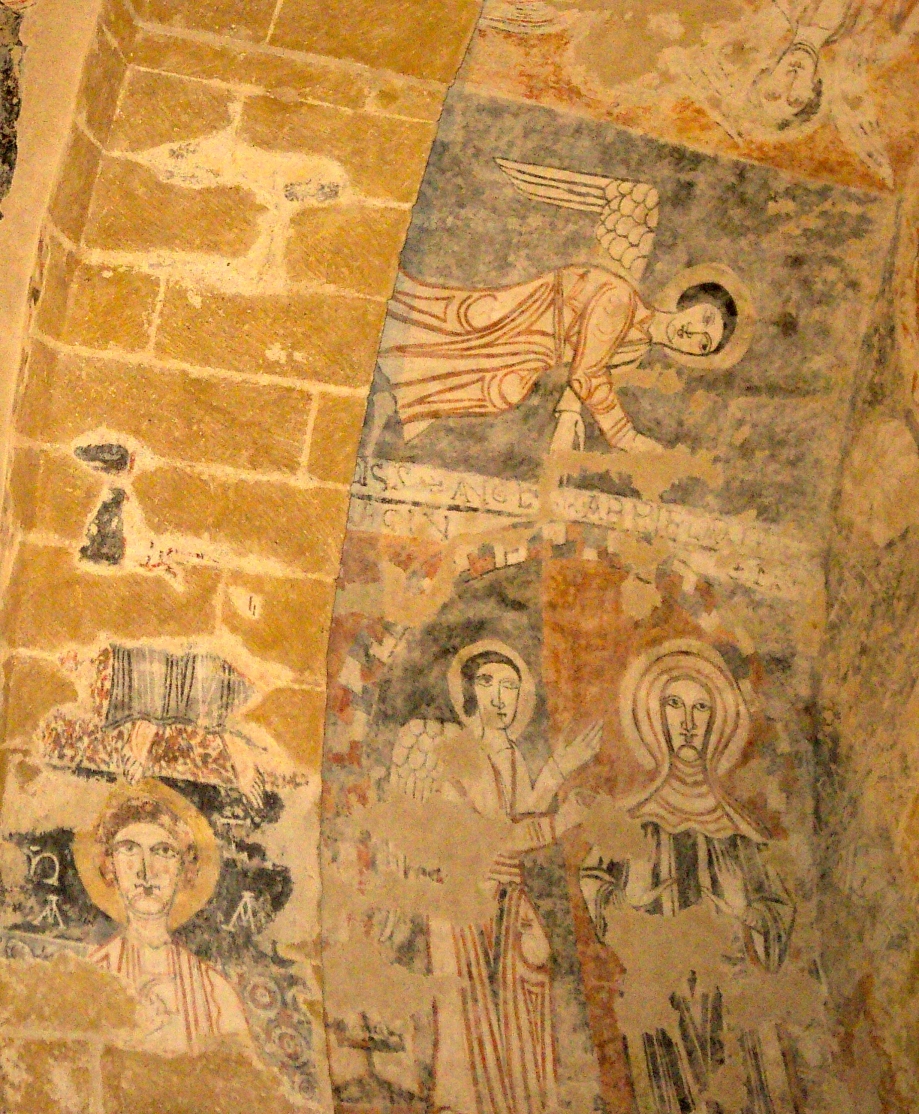
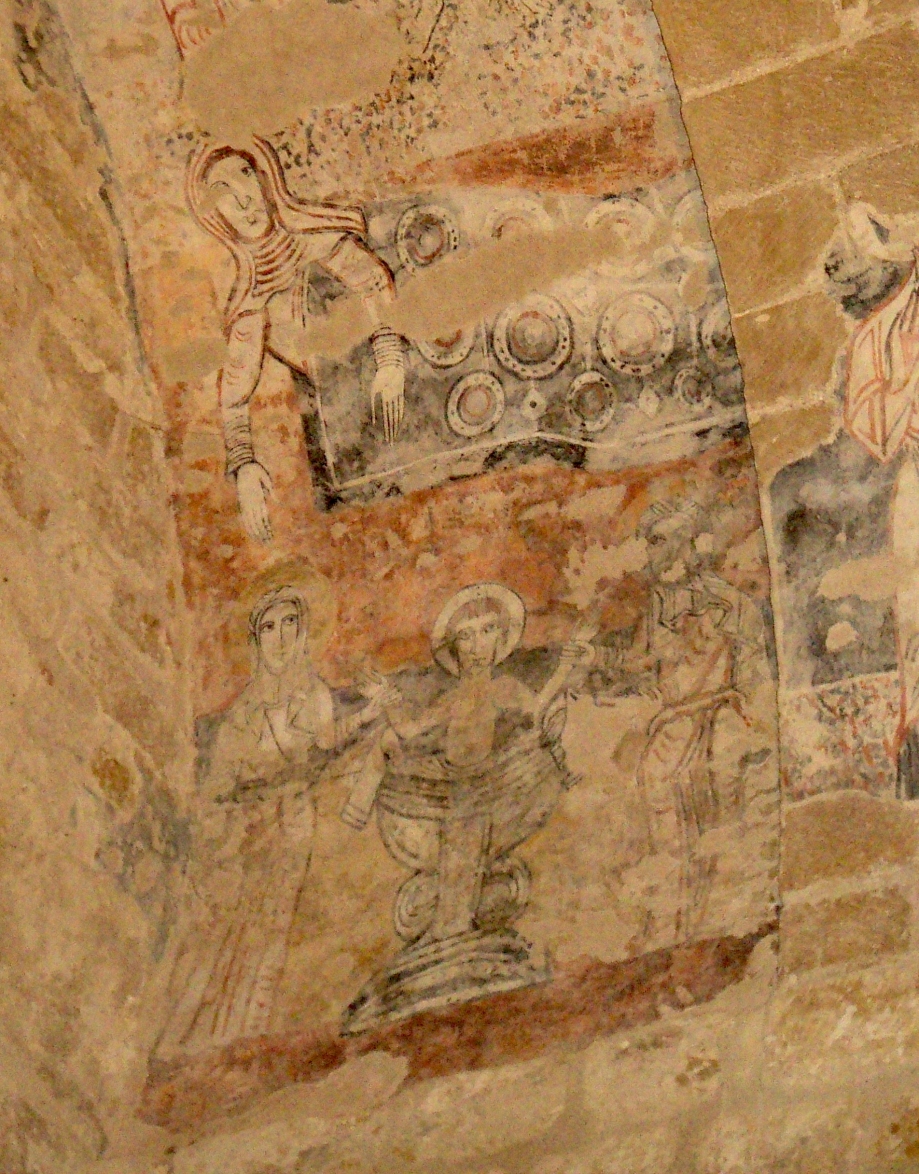
Scenes show the angels announcing to Mary that a child will be born, and then the newborn Jesus is baptised; once again represented as a little man. This second scenario is not in the regular gospels, only the apocryphal gospels, but "Church tradition" recognises the scene.
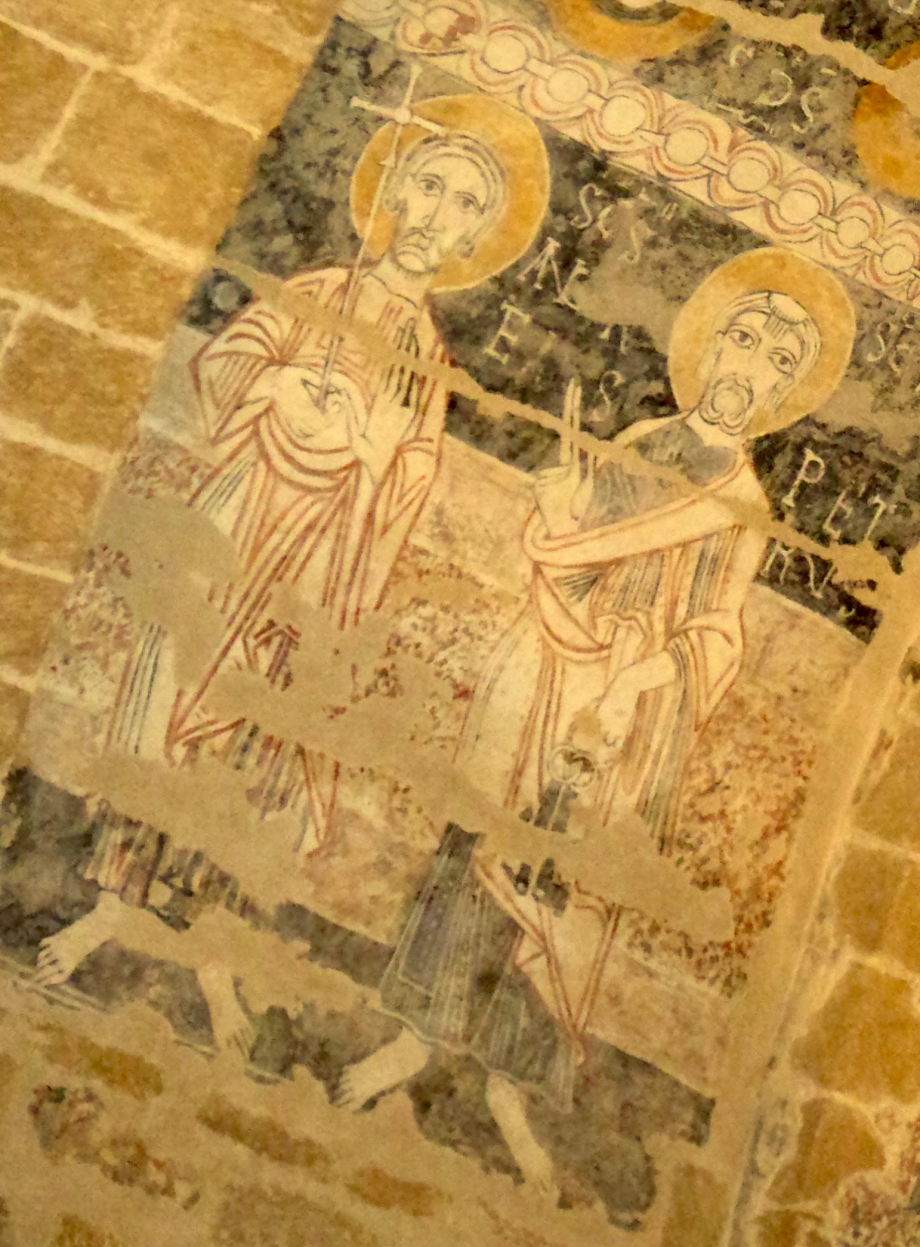
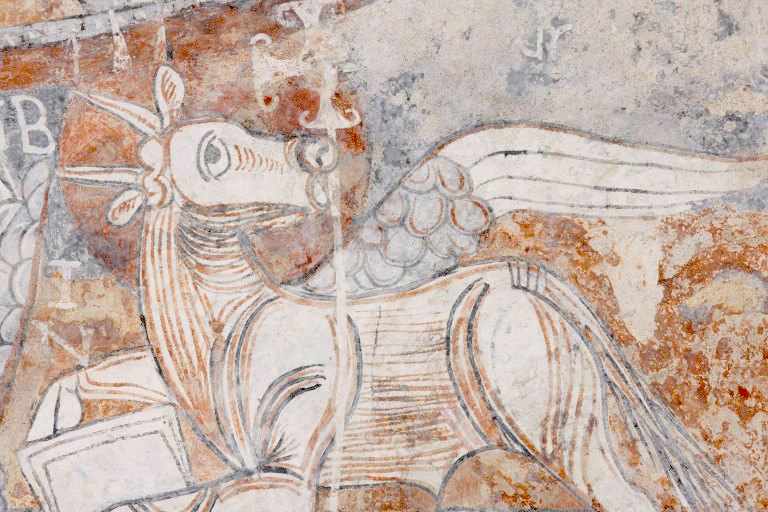
Some apostles; and the bull representing Saint Matthew.
These frescoes are Catalonian in nature and dated from the second half of the 12th century (1160?) during the time of the Lord of Vals, Guillaume Azéma the father. They were only restored in 2007 and 2008 and showed three aspects of the life of Christ - his arrival in the world, the period of the evangelists with the apostles, and what the French call the Parousie - Christ in majesty, surrounded by the 4 apostles. Among the characters who surround Jesus, are the figures of four archangels-advocats, a rare image.
I had an experience then. Mary was ecstatic about the frescoes, I had never seen them but had known they were there. "Just look!" she said and I nearly said; "I know them because I painted them."
Then I had to shake off this thought; the Lord of Vals, Guillaume's father, did not paint them but he commissioned them. But who actually came to Vals to paint these frescoes?
The frescoes were the work of the artists of the workshop of Maître de Pedret of Catalonia (probably Barcelona.) I thought Pedret wa the name of the man, but no, his name is unknown, Pedret is the name of the town where he had his workshop in the early 12th century. The "master of Pedret" was so named after his representative work, on the right side of the apse in the church of "San Quirze Pedret" - a church presumably - which can now be seen in the National Museum of Catalonian Art in Barcelona. Did the Master of Pedret come himself to Vals, with a troupe of artists?
The frescoes are Byzantine in style, impersonal “but rich in spirituality.” The colours were red, black, grey, yellow and white, now very faded, but the graphic quality is strong. The archangels hinted at the apocalypse - thinking of Lazarus perhaps? There is a scene to Lazarus on the way up the tower, Jesus raised him from the dead. Among the frescoes, only one of the three kings is visible, Balthazar is wearing a bonnet or cap, but apparently this was how the Spaniards represented the three kings.
Here is another Pedret fresco, originally from the church of Santa Marie d'Àneu in Catalonia, now in a museum called The Cloisters in New York! Sacred Feminine fans will love the shape in which enclosed the Virgin Mary and her child, again painted like a little man.
Work don by the master of Pedret, or perhaps we should say his school, can be found in Ariège in the cathedral of St. Lizier and in the church at St. Pierre at Montgauch.
A French web-site about Vals tells us; Le Maître de Pedret peint, à la façon des icônes, des « images anticipatrices, prospectives, prophétiques », dérivées de « la pensée en Dieu de ce qui sera », i. e. contemporaines de la Révélation, et, à ce titre, consubstantielles à cette dernière. De telles images ne représentent pas l’histoire de la Révélation ; elles la font venir, en inspirant, non sur le mur, mais dans l’âme de qui se tourne vers elles, la vision de ce qui vient, laquelle est per se acte, ou petitio.
Fortes d’un « contenu théologique élaboré », ces images s’adressent à ceux d’entre nous qui ont appris à marcher dans la forêt des symboles, ou requièrent, sous l’auspice des apôtres et des anges, l’intervention de quelque exégète.
The Master of Pedret paints, in the manner of icons, "anticipatory images, exploratory, prophetic" derived from the "thoughts of God about what will be" which are contemporary with the Revelation (of St. John.) The images do not represent history, but what is to come, and are inspiring, not the image of the soul which turns towards them, but the vision which comes . . . these images are addressed to those of us who walk in a forest of symbols . . . I have left in the original French for those who can read it, in case I have missed something.
Then, at Vals, from this Marian church we went up some steps to the St. Michel church, that was at one time separate, until the 15th century when the two churches were joined. Here the architecture is much more "light" in style, elegant and spacious.
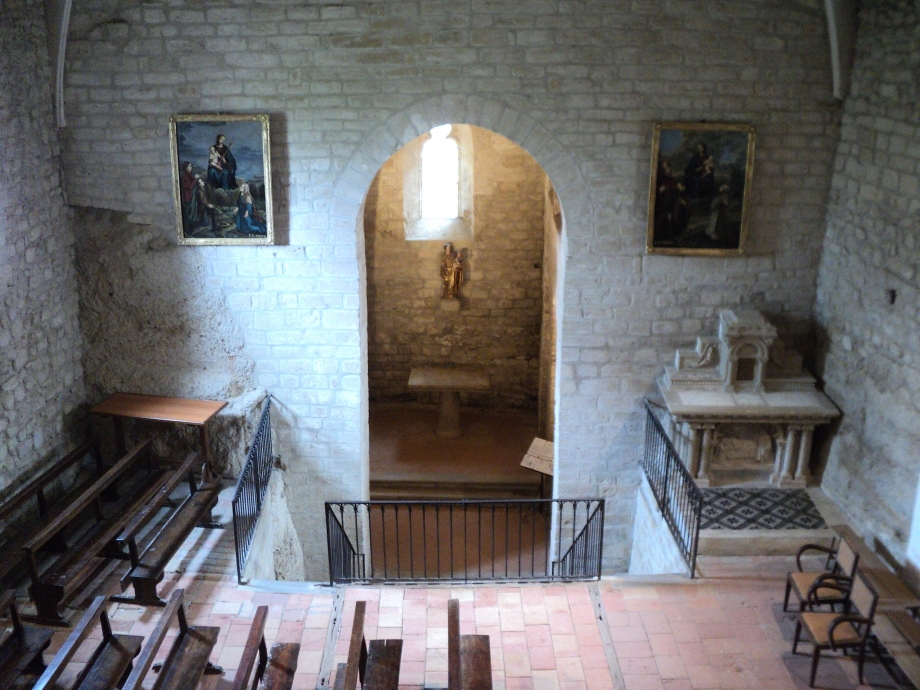 On the left as we came up the steps was another altar, modern in concept, showing Lazarus being raised from the dead - a resurrection theme. On the top of the altar are the symbols for alpha and omega, the beginning and the end, a Gnostic/St.John concept. Shades of Catharism? For myself I think Lazarus wrote the Gospel of St John, he was Mary Magdalene's brother and the disciple that Jesus loved. When you think that Lazarus under the name John, also wrote Revelation in the Bible, apparently after experiencing his "death" in the tomb before being revived by Jesus, and compare his "prophecy" with that of the frescoes in the church, it might occur to you that Vals church is not like others and its 12th century mysticism not like today's.
On the left as we came up the steps was another altar, modern in concept, showing Lazarus being raised from the dead - a resurrection theme. On the top of the altar are the symbols for alpha and omega, the beginning and the end, a Gnostic/St.John concept. Shades of Catharism? For myself I think Lazarus wrote the Gospel of St John, he was Mary Magdalene's brother and the disciple that Jesus loved. When you think that Lazarus under the name John, also wrote Revelation in the Bible, apparently after experiencing his "death" in the tomb before being revived by Jesus, and compare his "prophecy" with that of the frescoes in the church, it might occur to you that Vals church is not like others and its 12th century mysticism not like today's.
I feel a link here with Catharism but have not yet pinned it down.
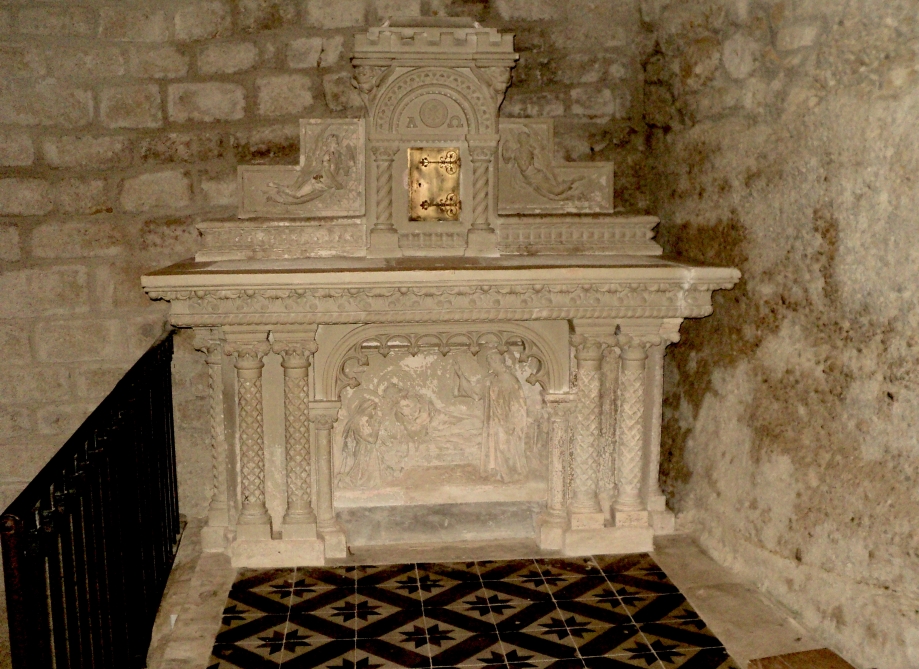
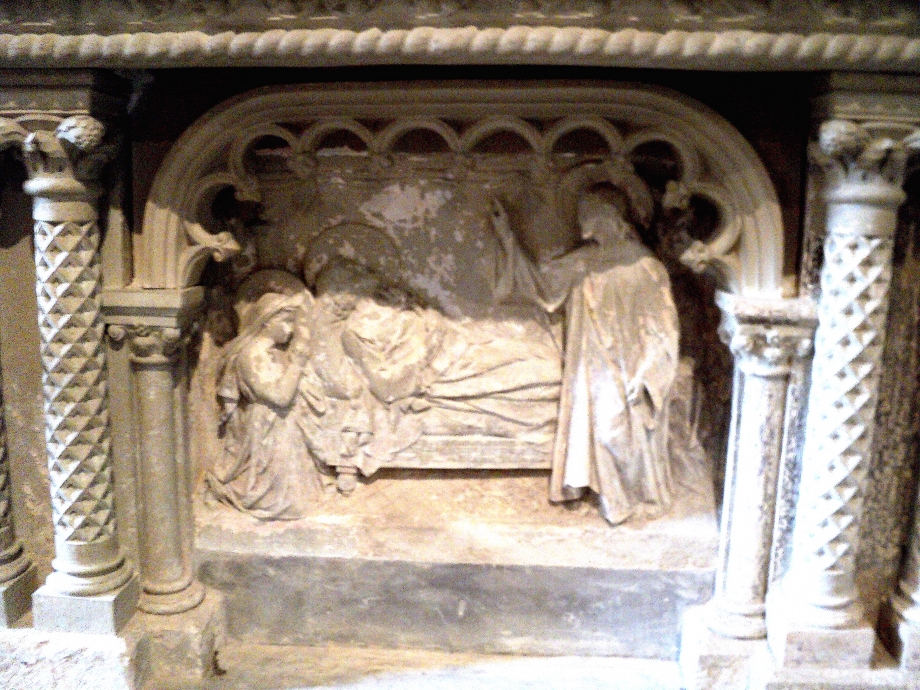
And we found two strange wooden statues that were very old indeed; from the lower church I was sure. Both had suffered badly from woodworm.
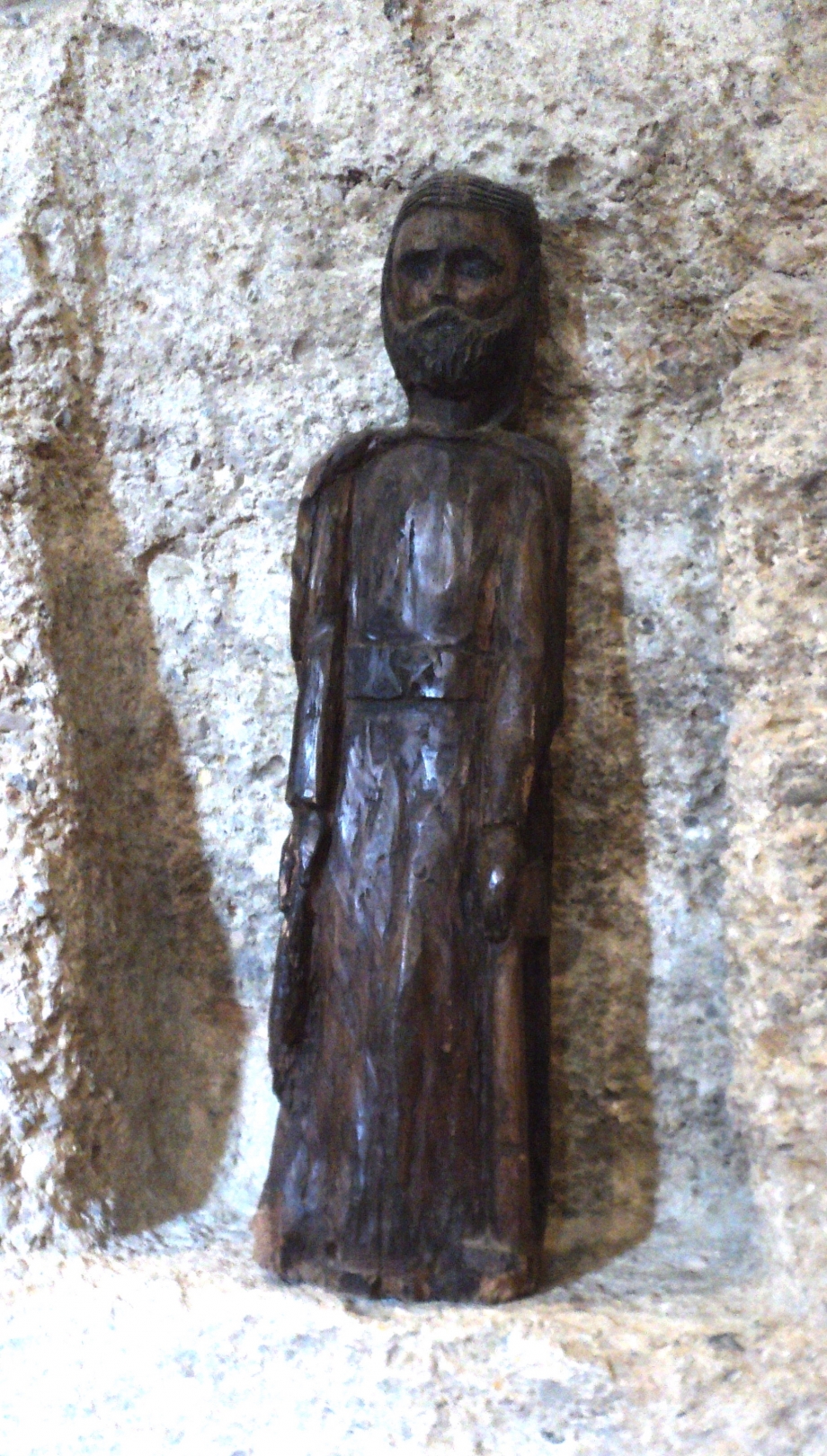
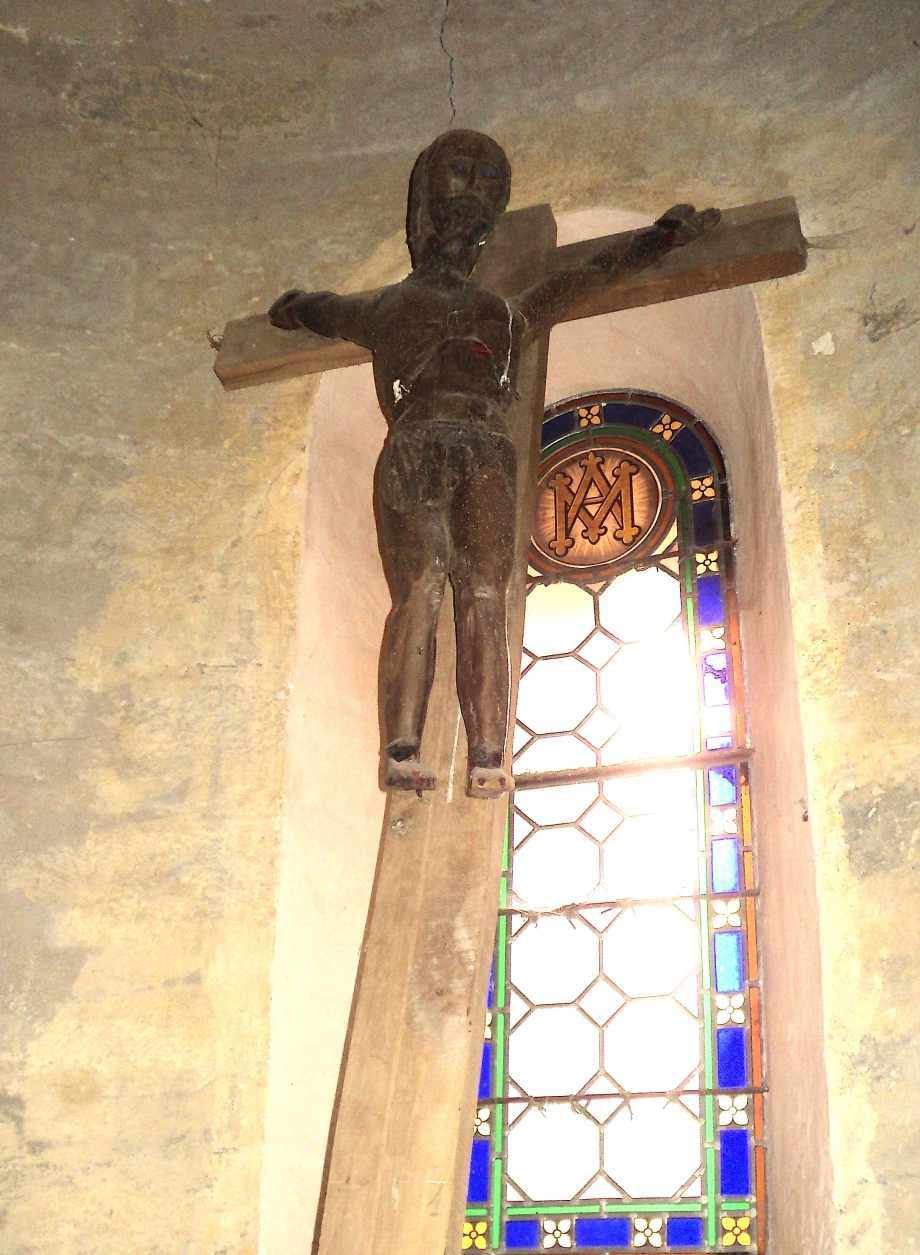
The first one looked like a nobleman - Guillaume? He had such a fine head and his robe, with its large buckle, like like a medieval nobleman would have worn.
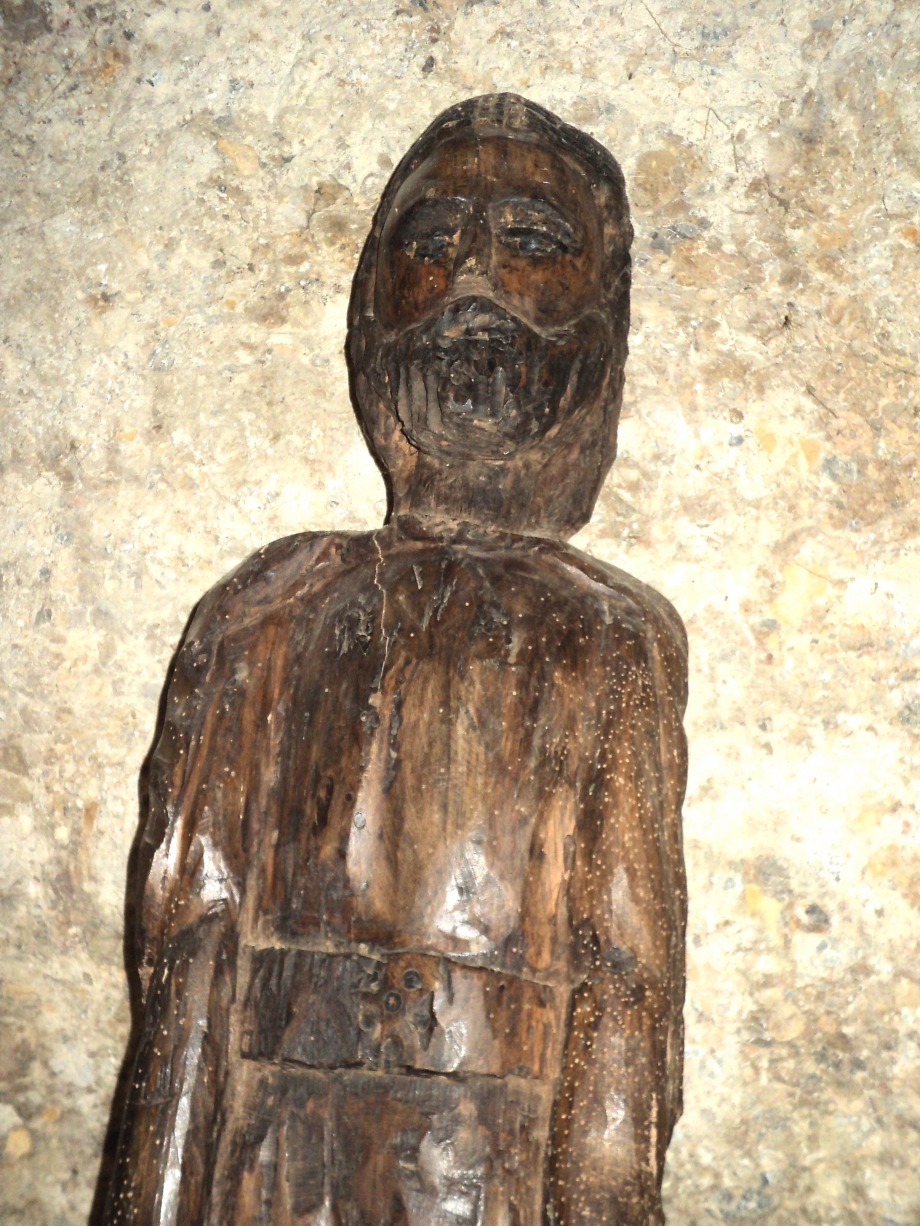
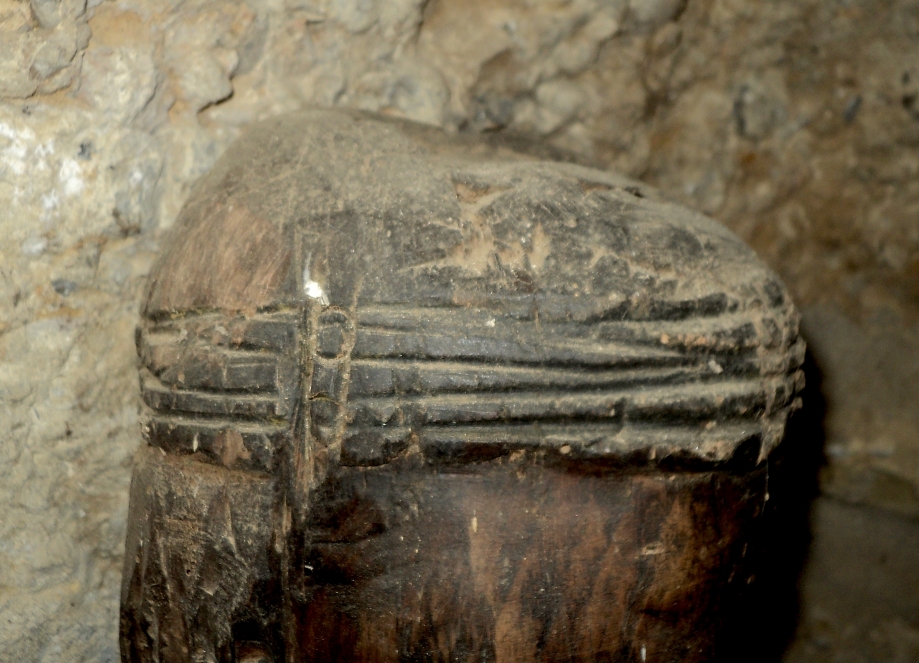
He appeared to be wearing a cap of some sort but on inspection this was a headress in the Judaic Biblical style. Aha!
The statue was quite narrow or flattened from front to back, so I tried poking the camera between the back of the statue and the wall and this is what I got -
It was S(aint) Joseph!
And so we (I am indebted to Tina for helping me with this research and photos) we continued to the wooden crucifix, obviously made at the same time and by the same artist. What we found there was amazing.
Jesus's eyes were painted blue! Why and when this was done is a total mystery. You cannot see it from a distance, against the light of the window behind.
In this room is also St. Michel himself. There's a tradition in the church that he was given authority to protect all Marian churches.
From St. Michel's church you can go up into the tower. Sometime "after the 13th century" the tower became defensive. I wondered if the Crusade against the Cathars had anything to do with this. At this time the two churches were not joined. Certainly the tower was defensive during the Wars of Religion of the 16th century. Perhaps that was what caused the fire that was not repaired until 1887.
Today there is a door leading to a fine courtyard with a view all over the village and the Pyrenees beyond. If you look backwards to the tower above you you will get vertigo in reverse.
But the cross on the wall is interesting.
It reminded me of crosses found in the Visigothic graveyard of Montferrand, to the north of Vals on the Carcassonne/Toulouse road. I am passionate about the Visigoths and so wondered if they could have known Vals? Yes - a Visigothic centurian's belt buckle was found when Talus was excavated.
And so we descended to take a look around outside, finding this map which was most useful.
The blue bit is the church. We were where is marked in red, and Tina explored the crack in the rock called Faille de la Source, which must have been where the original source was. Excavations here, as recently as 2008, revealed about a dozen bodies, dated as Bronze Age, that is, pre 500BC. The little book I bought later in the museum explained that these fragmented bones of men, women and children, were all mixed up together, which seems like an emergency burial, rather than a graveyard one. This was long before the church was built of course, and the archeologists could not investigate the land under the church.
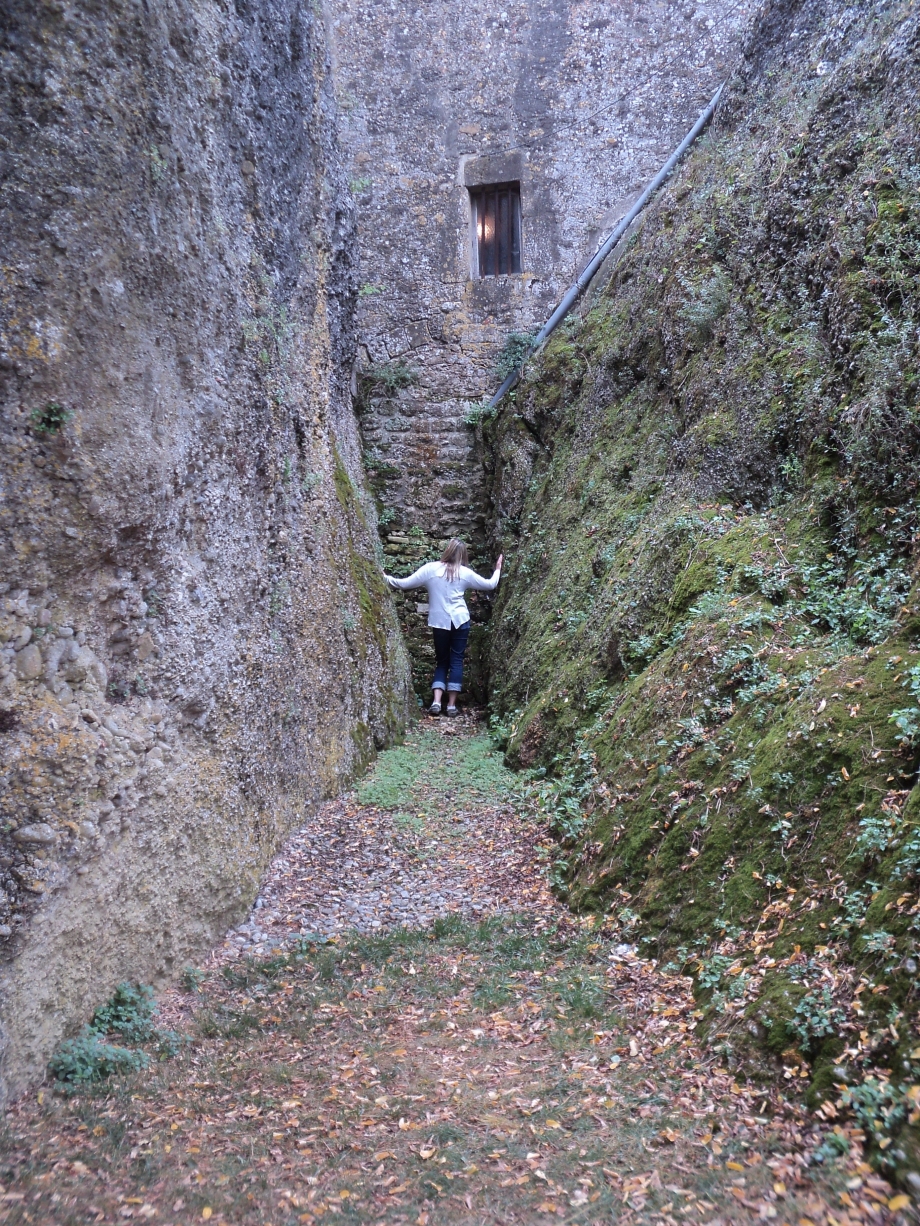
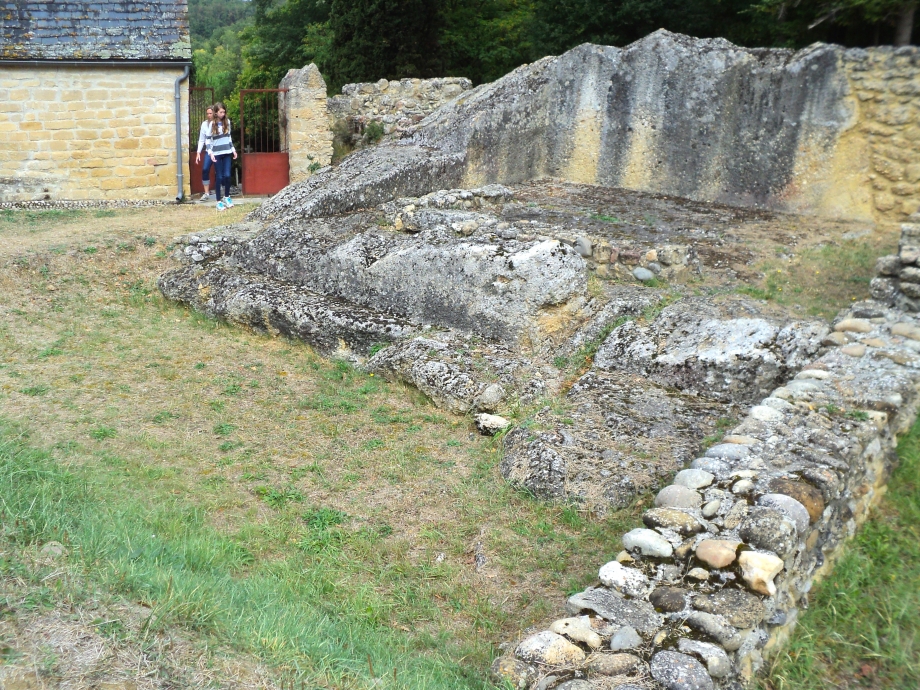
Then we went for a look at the Roc de Tailhat, beside the church, in the area called Talus.
The archeologist originally thought these ruins were Iron age but they were eventually dated as 800BC, but it had existed for 200 years before that. Excavations revealed a structured site - calcinated wood was dated 10,000, 900 or 800 years BC, then Gallo-Roman stuff was found nearby. The ruins made it clear there was trading going on with the Mediterranean at that time. Also found there was a magnificent stone axe with a wooden handle. The archeologist was called Abbé Durand and his colleague, Annie Cazenave, said there must have existed at Vals an early pagan cult entirely underground.
A graveyard with graves on Talus at various levels is thought to have been Merovingian (but read on to see what the museum says.) Then there was that Visigothic belt buckle - ah! Around 507 or 508 the Visigoths were fighting the Merovingians in this area, and they lost Toulouse. The Merovingian/Visigothic border moved to Montferrand and then Lastours on the Montagne Noire, from where came the Visigoths who founded Rennes-le-Château. And so there was a battle at Vals, the Merovingians won it for they buried their dead properly, but not the Visigothic dead. (French formal history rarely mentions Visigoths. They go straight from the Gallo-Romans to the Merovingians. They are not that keen on admitting Catharism either.) When the Franks tried to take Languedoc in 507 or 8, Limoux was firmly Visigothic, and Mirepoix and Vals are not much further to the west.
The archeologist at Vals, Abbé J. M. Durand is practically worshipped at Vals for the archeological work he did. A "Friends of Vals Association" was formed in 1958, two years after his discoveries and they have published several books describing the archeological work. Abbé Durand also did a lot of work around Montségur. He discovered that the bodies found in a cave near Montségur were not Cathars who had been bricked up there to die (as the Neo-Cathars tell us) but were Iron-Age - circa 500BC.
Then we went to look at the cemetary.
It must be one of the most beautiful in the region. It is still in use and I was looking for the name "Azéma" on the graves, but never found one. I was surprised because I had seen the name "Azéma" as a guardian of the church when I was researching at the tail end of 2014. There was a man sitting in the Mairie and the door was open, so I asked him if the Azema's still lived in the village. "They used to do," he said, "But there are no Azémas here now."
Where had the Azema's lived, way back when they were the Lords of Vals in the time of the Cathars? Did they have a castle? The houses in the village are old - some 16th century - and many could have been build on 12th century foundations, but nothing looked anything like a stately home.
Maybe the Roc Taillat had been their home?
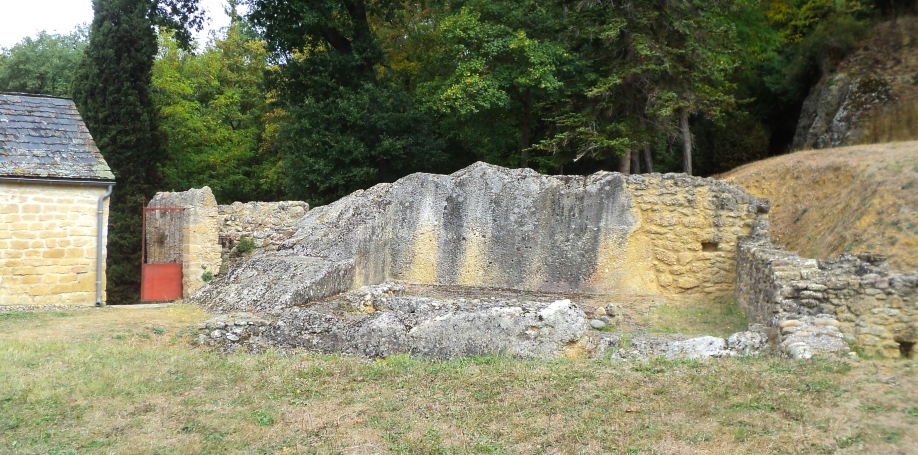 It was a Sunday and to my great disappointment the museum was closed. I needed to find out much more about the history and exactly what the abbé Durand found.
It was a Sunday and to my great disappointment the museum was closed. I needed to find out much more about the history and exactly what the abbé Durand found.
It looks as though the museum is housed in the local café! But the café/restaurant is behind the museum.
Just found a link (in French) with details and pictures of the museum and how it was founded. Click here.
Ten days later - we went back!
This time I did a lot of checking before we left to make sure the museum would be open. I rang the Association, Friends of Vals, who run the museum but all I got was on old lady who told me a long story in French about how her hearing aid didn't work! But eventually we got confirmation that the museum would be open.
The museum calls itself a "Bar-Expo"! Many people see the bar through the window and stop there for a drink; the museum part is behind the bar. Original! Let's start with the oldest exhibit of interest.
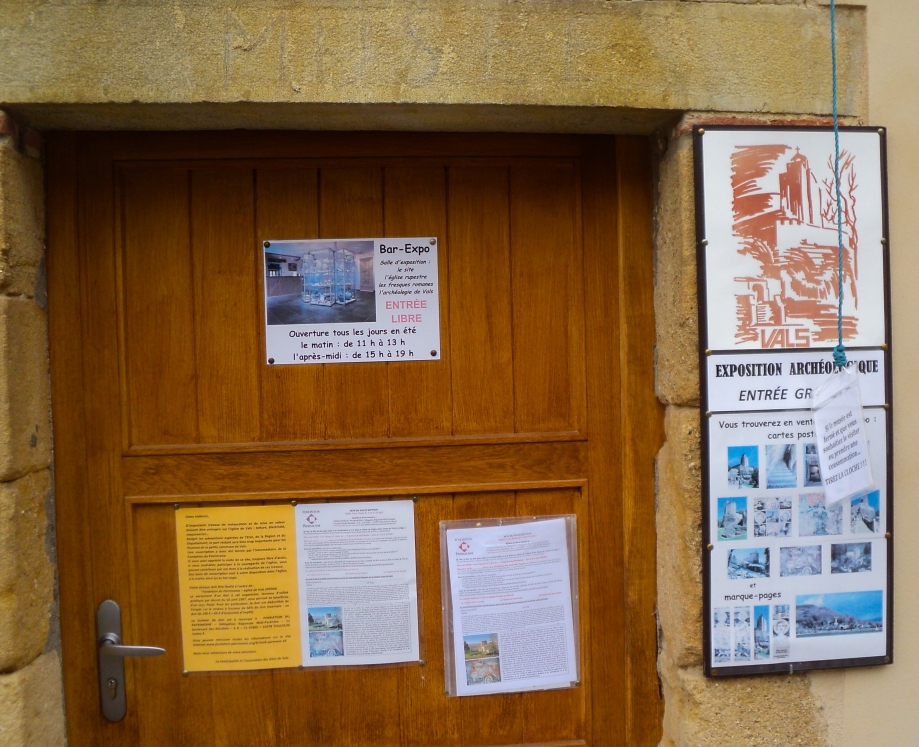
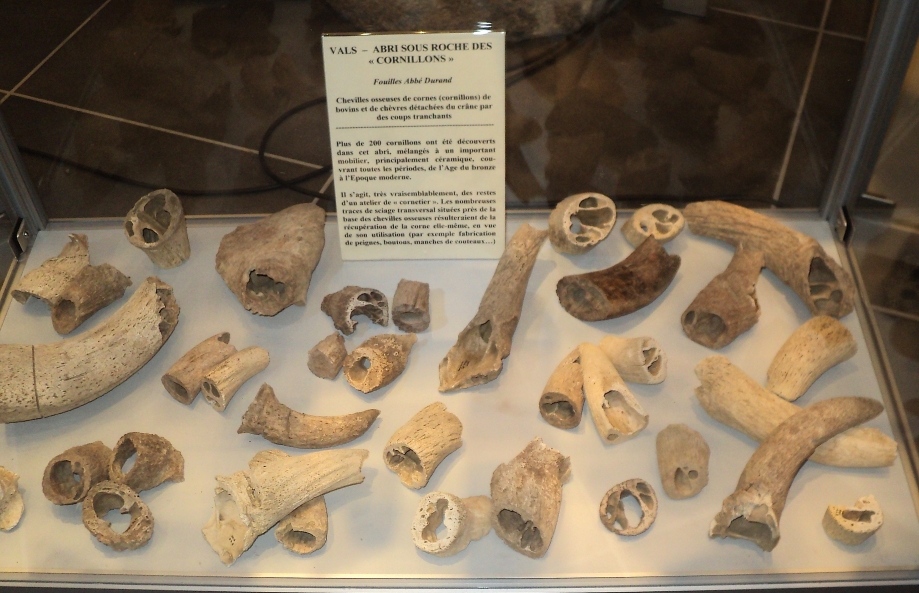
These bones were prehistoric - well before 500BC - and show the people living there had a workshop to make things out of bone. Then there were many Roman remains. The archeologists have explained that this collection implies that there was a "cult" under where is now the church, where fine pottery - as sigillee is - was found, and many vases and amphores. In short - there was a Roman temple here!
The next displays were of the Merovingians, that various articles on the web told me had lived at Vals. But they weren't buried there.
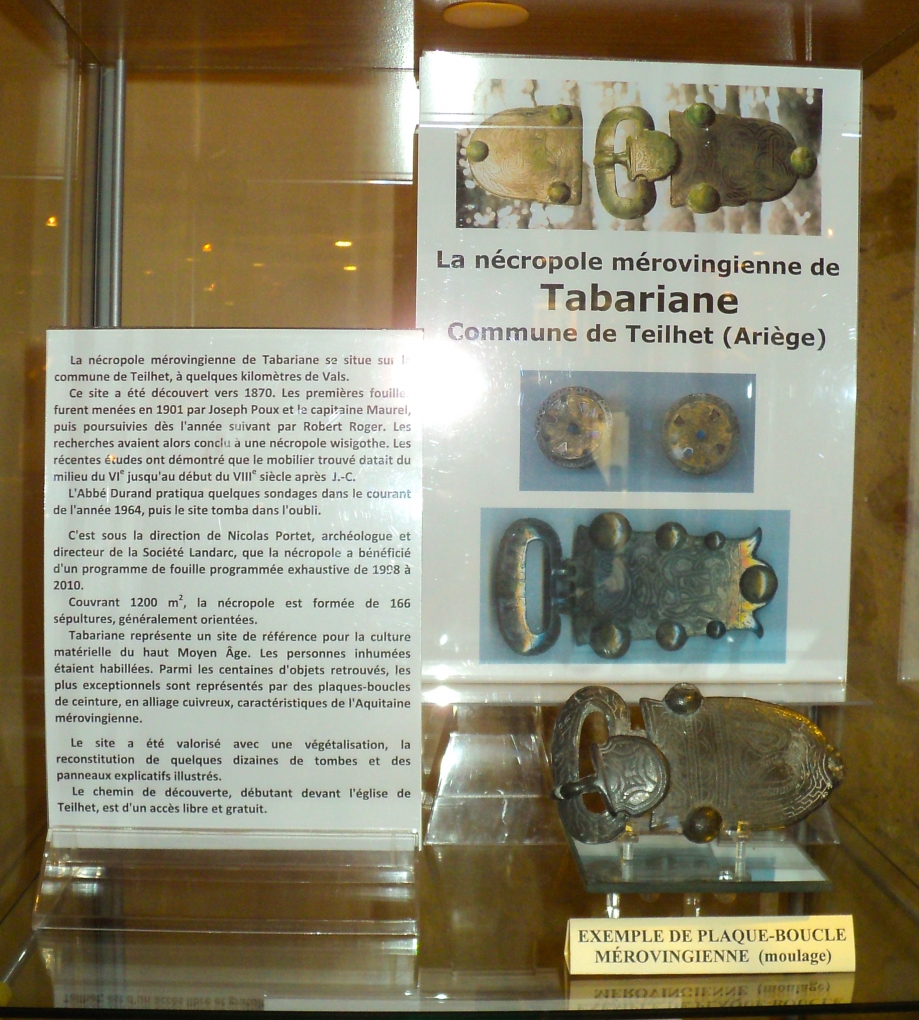
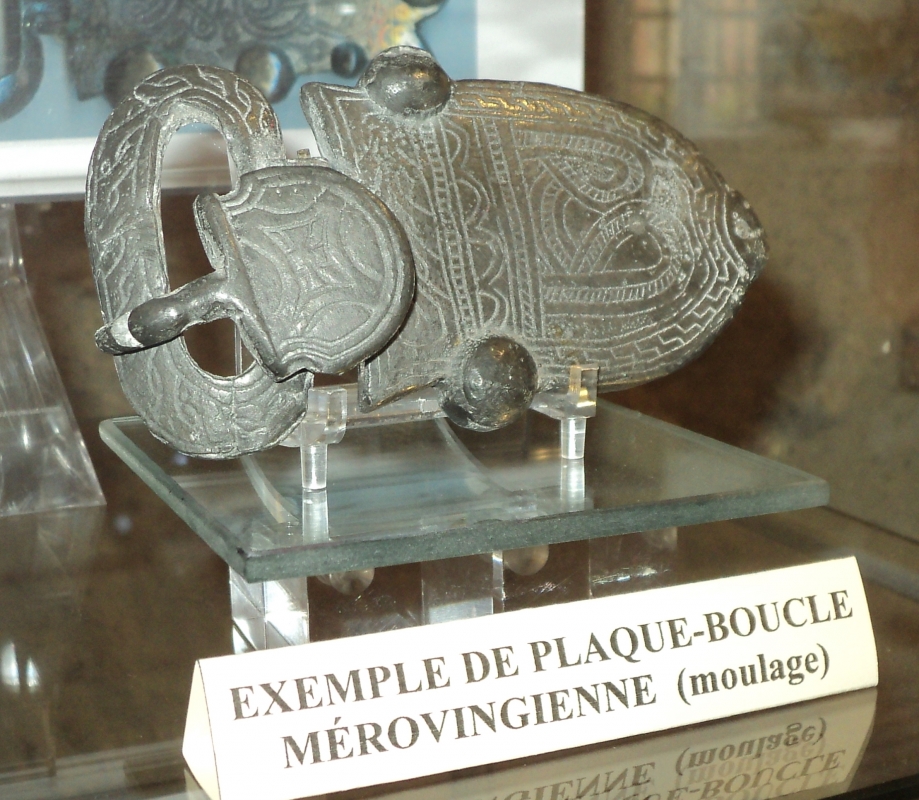
Their graveyard was at Teilhet, a village just 4km from Vals as you approach from the Mirepoix direction. As we had passed it on the way we had a discussion about the name - we thought it was Germanic rather than French, unlike all the other names in this region. In case you are wondering, the Franks/Merovingians were indeed Germanic in the 6th century. Maybe they founded Teilhet simply for their dead? Yet the archeologists of Vals insist that the only Merovingian thing ever found was the tiniest part of a buckle.
I asked the lady in the museum if the Visigoths had ever lived at Vals. "Oh no," she said, quite shocked, "We never had Visigoths here!" But I know they did, because "Azèma" is a Visigothic name.
Oh well, on to the Middle ages, the time when the population increased enough to build the church. Some pottery found had been dated as "Carolingian," late 8th century, early 9th.
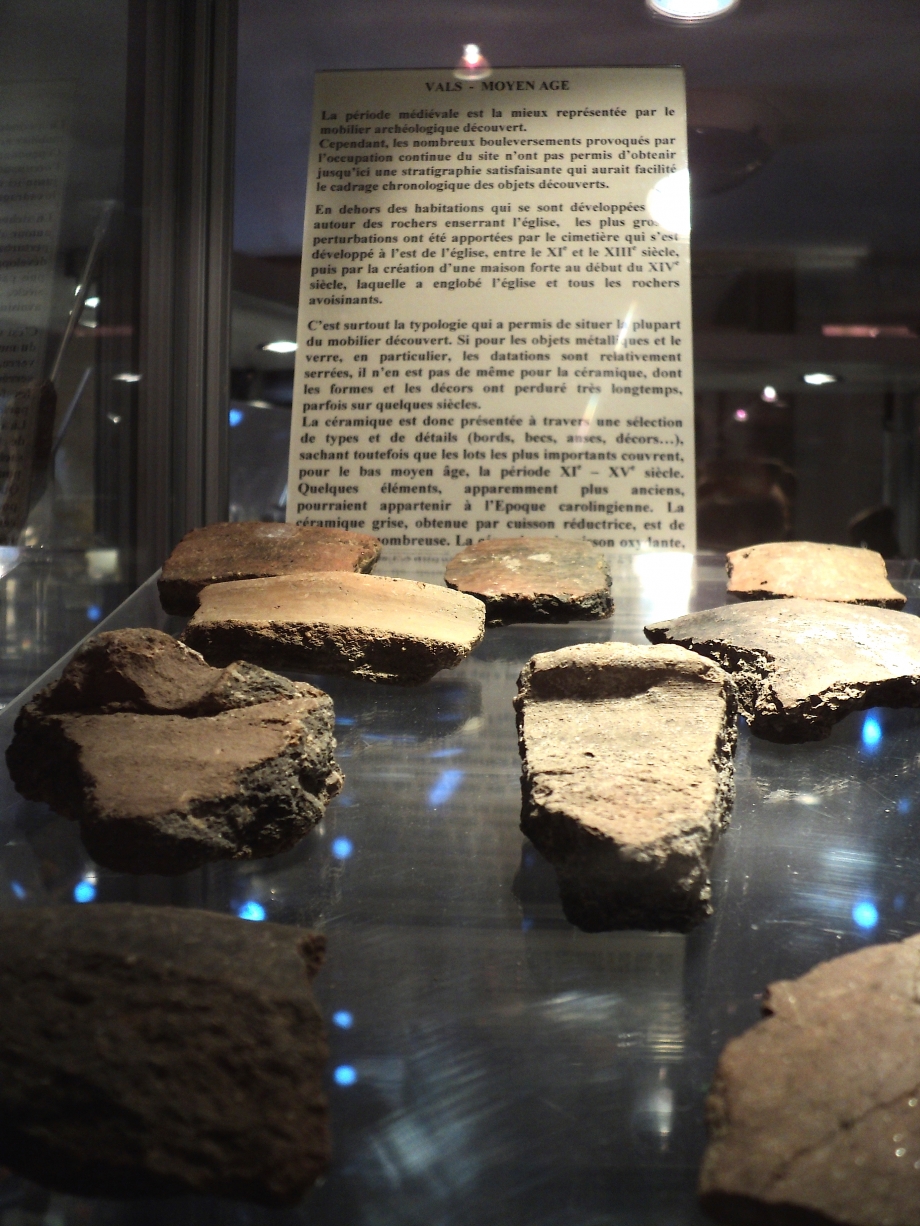
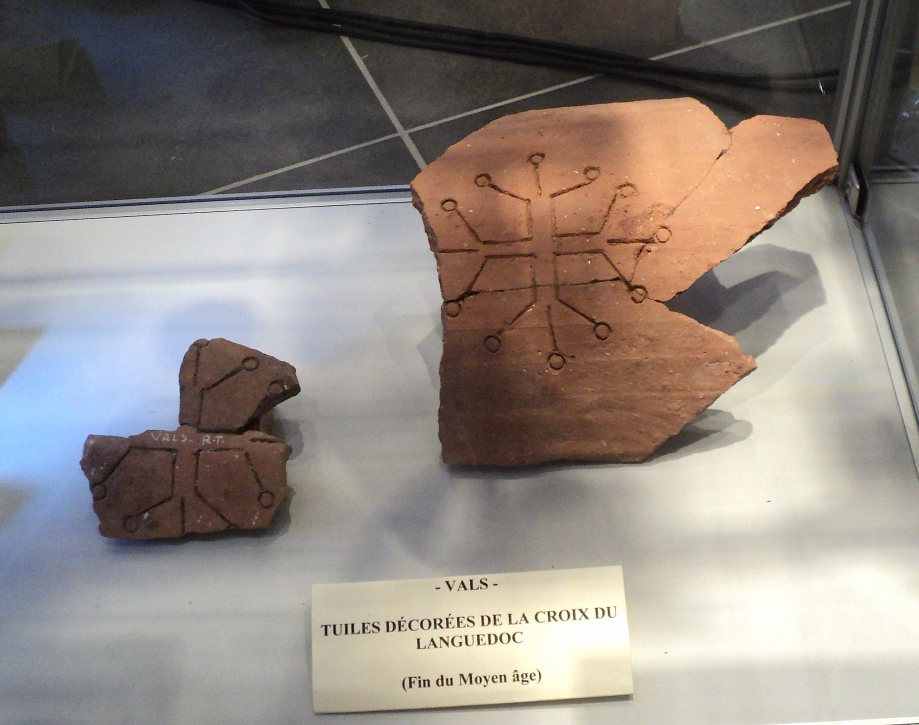
The archeologists found lots of 11th century pottery - from the time the frescoes were done - and an Occitan Cross or two - sketches in stone. Now things were getting interesting!
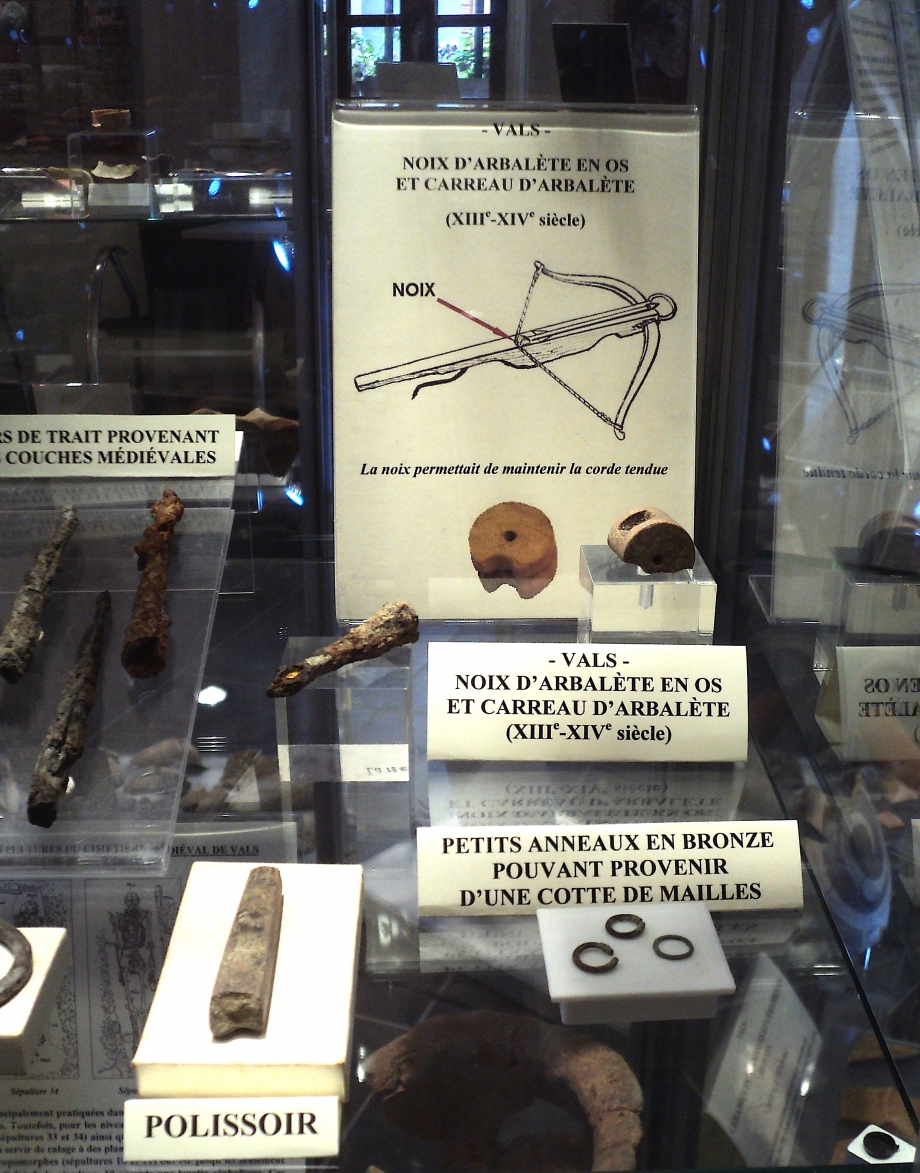
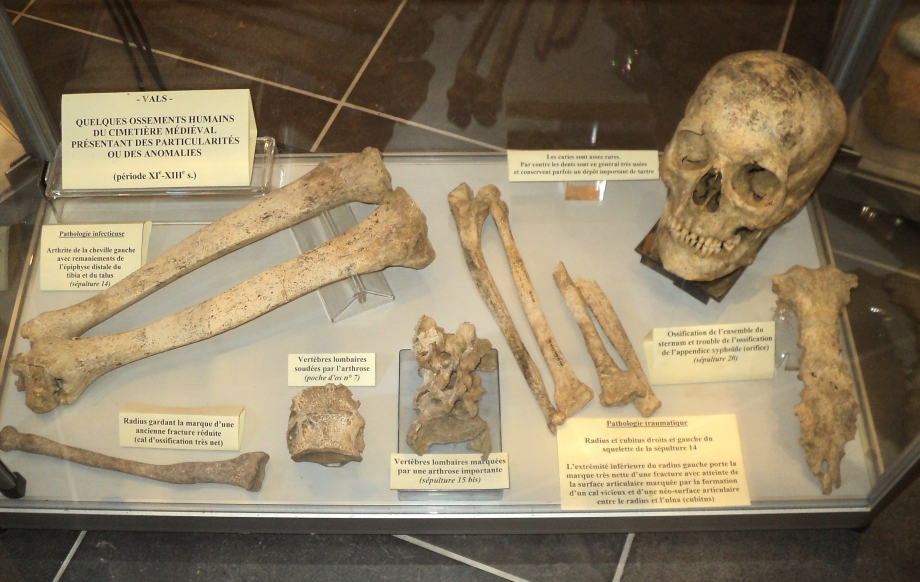
A cross-bow that could have been Guillaume's and some bones that could have been his. I was nearly spooked.
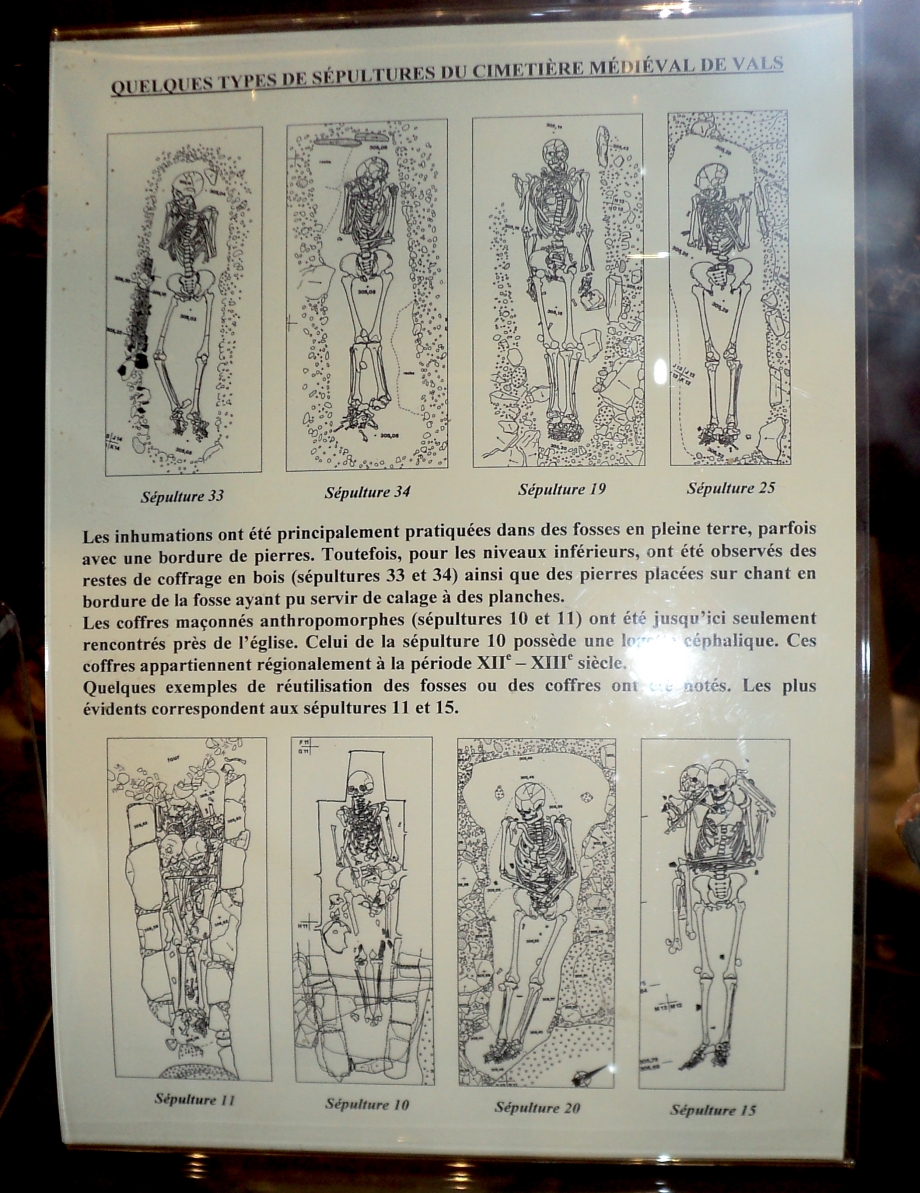
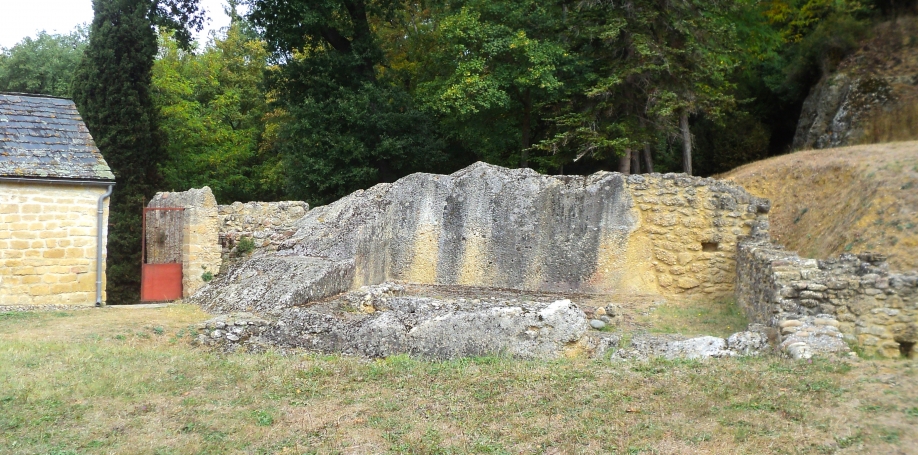
Some medieval graves were found between Roc Taillat and the church - right by this red gate which leads into today's cemetary, so these graves could well have been the origin of today's cemetary behind the church. The earliest - oldest? - bodies were buried facing east-west. The archeologists seem confused that no personal possessions were buried with the bodies and some looked as though they had been thrown on the top of others. Did a battle take place between 1200 and 1300 at Vals? The skeletons were dated from the 12th to 13th centuries - the times of the two Guillaumes. Did they live in this house, as I have mentioned before?
Some glassware was found at Roc Taillat, elegant enough to grace the stately home of the Lords of Vals, the two Guillaumes. The glass was all broken pieces, which implies that the ditch was a rubbish dump and the servants were told to put the broken glass there so no-one got injured. And so I think Roc Taillat was the house where the aristocracy lived including the Azémas in the late 12 and early 13th centuries.
I asked the lady in the museum, wording my question carefully, "Can you tell me anything about Guillaume Azèma?"
"He wasn't a Cathar!" she said immediately. "Many people think he was but he wasn't!" She sounded scared that anyone might think Vals had anything to do with the Cathars, and she had been asked the question before. Then she had to go and serve at the bar.
In this "Museum" are one or two showcases with small finds of pottery from elsewhere, such as Montségur. I read on the Internet that several items found at Vals are now in the museum at Tarascon . . . as we have seen with the frescoes, museums like buying and selling things and passing them around, which can be frustrating, when you discover that what you really came to see is in another museum.
Mirepoix. A haven of light under the arcades - rain was threatening!
On the way home we went to Mirepoix, the home of Pierre Roger de Mirepoix, Guillaume's colleague and friend, who was an ardent Cathar. In the Crusades against the Cathars Simon de Montfort took the town and gave it - which also meant giving rights over all the town's revenue - to his lieutenant Guy de Levis. It was a wealthy town with 2000 inhabitants, many shops and businesses. Pierre Roger and his family were landless and homeless and so eventually went to Montségur, an action which effectively declared them Cathars.
However, the Mirepoix you see now is not the town it was then; in 1279, the barrage at Puivert ruptured and caused massive flooding that destroyed the whole village, sparing only the château. Ten years later the town as we know it now, designed as a bastide, was built by Guy de Levis. That's why there a few historical remains at Mirepoix - the flood swept everything away.
The centre and the cathedral are worth seeing however, and the people in the cafés very friendly. We were ready for lunch by then!
Inscrivez-vous au blog
Soyez prévenu par email des prochaines mises à jour
Rejoignez les 28 autres membres

